Wildlife
of the
Southern Pantanal
Photo Tour
September 2016
Trip Report
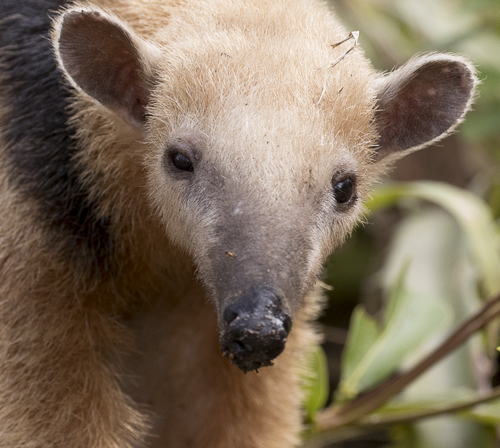
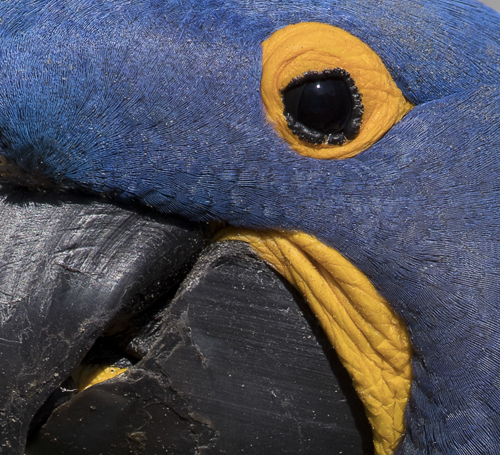
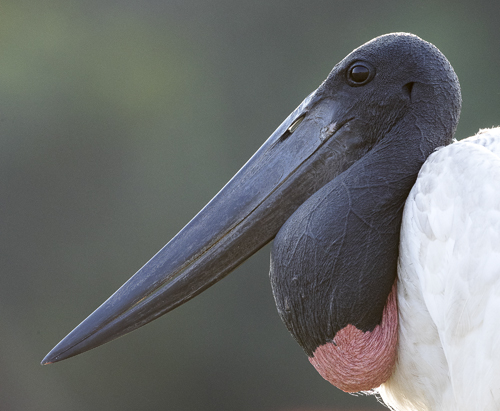
Day One. We arrived in Campo Grande at 10:30PM, after a long day of travel that began with our bus ride to Cuiaba at 6AM. We didn’t arrive at our lodge, P A, until 1:45AM, and to bed by about 3AM. A long day, with dreary skies but no rain.
Day Two. Our First Location.
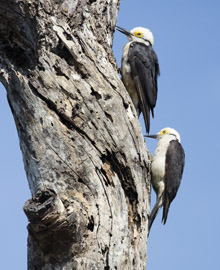 I awoke at 7:20, although earlier the birds and the staff had me awake, but the rest was good and we were rewarded with sunny skies! At breakfast we had several new birds, Giant Cowbirds, Plumbed Jays, and the usual, and at 9AM we did a walk for wildlife. All of us carried 100-400 or equivalents, and I was happy I did, as the 800mm would have been heavy, cumbersome, and, ultimately, not needed for the highlight of the morning.
I awoke at 7:20, although earlier the birds and the staff had me awake, but the rest was good and we were rewarded with sunny skies! At breakfast we had several new birds, Giant Cowbirds, Plumbed Jays, and the usual, and at 9AM we did a walk for wildlife. All of us carried 100-400 or equivalents, and I was happy I did, as the 800mm would have been heavy, cumbersome, and, ultimately, not needed for the highlight of the morning.
After seeing and photographingWhite Woodpeckers, Bare-faced Ibis, Burrowing Owls, etc., we found a Giant Anteater that we spent nearly an hour with. We kept downwind, and we were quiet, and often the Anteater walked within frame-filling distance of a 300mm. It was great shooting, which we abandoned around 11AM as the sun was high, and we had shot A LOT of anteater images!
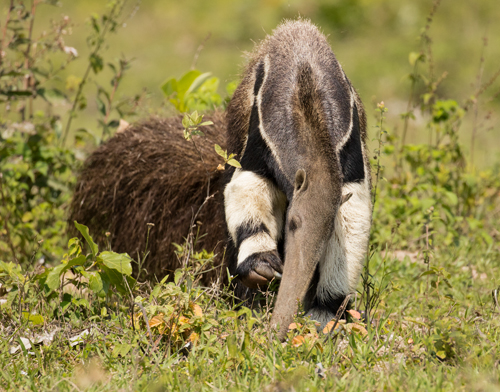
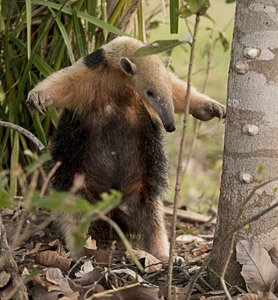 PM. We saw at least 9 Giant Anteaters this afternoon but the morning shoot was so good we passed on every one of them. This is unheard of!!! However, we were after ‘bigger’ game, hoping to get a mother with a baby on her back. We did not, but the day was nonetheless a stellar one.
PM. We saw at least 9 Giant Anteaters this afternoon but the morning shoot was so good we passed on every one of them. This is unheard of!!! However, we were after ‘bigger’ game, hoping to get a mother with a baby on her back. We did not, but the day was nonetheless a stellar one.
Shortly after starting our game drive we had the first of 3 Tamanduas, or Lesser Anteaters. This animal has poor eyesight, and we were careful to be relatively quiet except for the click of our shutters, and at times the Tamandua walked within ten feet of us. I was glad that this time (unlike my first Jaguar Trip this year!) I had the correct lens. We actually had a choice – going for the Tamandua or a 9-banded Armadillo, but as it turned out, after doing the Tamandua we did the  Armadillo, and did well. At lunch, by the way, I photographed a pair of 6-banded, or yellow, Armadillos right beside our dining area, while we ignored the five Coatimundis that were walking around the grounds.
Armadillo, and did well. At lunch, by the way, I photographed a pair of 6-banded, or yellow, Armadillos right beside our dining area, while we ignored the five Coatimundis that were walking around the grounds.
Soon after the Armadillo we found the first of several Pampas Deer, and our great local guide drove the vehicle onto the correct side, sunlit, for nice 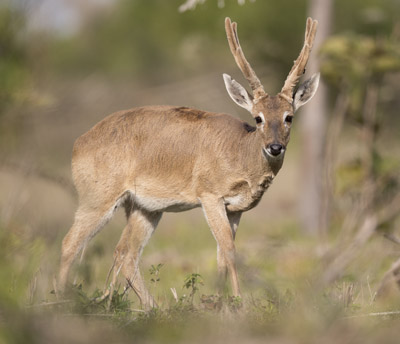 shots of the doe. After that, we found a male with his antlers in velvet, and while doing for him spooked a mother Jacare’ Caiman with babies on her back from the track. She did not return to her sunning spot when we returned, after photographing the deer.
shots of the doe. After that, we found a male with his antlers in velvet, and while doing for him spooked a mother Jacare’ Caiman with babies on her back from the track. She did not return to her sunning spot when we returned, after photographing the deer.
We continued, photographing another Tamandua, some birds, a nice ‘herd shot’ of Capybaras from an aerial perspective, and a Greater Rhea, and ending at a Caiman pond where we photographed Caiman feeding on fish with our wide-angle lenses – less than three feet away. Cindy 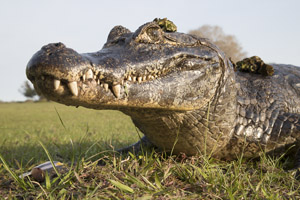 couldn’t believe she was this close to a wild crocodilian. It was fun.
couldn’t believe she was this close to a wild crocodilian. It was fun.
The afternoon passed rapidly and we headed back towards the lodge, stopping with the last light of the day for another Tamandua. This one, perhaps because it was near dusk and predators are about, spooked at one point and stood up, arms outstretched in its defensive posture. I videoed and shot the pose. While there, a Collared Peccary trotted by – our 7th mammal species for the day. We had more mammal shooting (other than 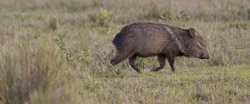 jaguars and giant otters) here in one day than in an entire trip in the northern Pantanal. We will return here, to be sure!
jaguars and giant otters) here in one day than in an entire trip in the northern Pantanal. We will return here, to be sure!
At dinner, the Crab-eating Fox arrived looking for handouts. I had brought along 7 Phottix Ares transmitter/receivers that I had hoped to use with the Ocelot in the northern Pantanal, but the fast movement, and fleeting poses of that animal made sharing flashes via the Phottix impossible. However with the Fox it was different, as the Fox held poses for minutes at times, and with only three shooters using the Ares it was easy to fire away. The multiple lighting eliminated all red-eye problems, and varied the lighting nicely, making the end of a very good day – at least 7 different mammals photographed.
Side Note: Our driver to this lodge was/is a guide for 16 years, and as I usually do with guides, I asked him what the most exciting or interesting thing he’s ever seen. Here is his, and it is unique: He was watching a Brazilian Tapir and Yellow-headed Caracaras, and the Caracaras began making their whistling noise or call. The Tapir appeared out of the brush and whistled back, a deeper, stronger whistle, but what the guide described as a whistle. The Caracaras responded. All this is just coincidence at this point. Then the Tapir laid down on its side, I think still whistling, and the Caracaras hopped down and proceeded to pick ticks (he supposes) off the belly and sides of the Tapir. To him, as he describes it, it was like, ‘hey, caracaras, I have ticks here. Help me out, take these ticks,’ or perhaps, ‘Hey, tapir. Do you have any ticks? Can we eat them?’ Either way, he said there is no way he is not convinced that the tapir and the caracaras were in communication. Why not? Various reef fish signal groomer fish like gobis that they are at the reef to be groomed, and instead of eating these little fish they placidly let themselves be picked clean of parasites. For fish, as far as we know, this signal is visual (but who knows what else might be going on?), but for birds and mammals, this signal could be, and probably is, audio or visual, or both.
Side Note 2: This lodge was well known for the Ocelots that visited a fishing camp nearby, where fishermen gave the Ocelots scraps. This was so reliable that it was a photo destination, and almost a sure-thing for Ocelots. Tonight, I asked an acquaintance I met here whether or not he was going to visit the Ocelot Fish Camp. He called over his guide, and asked him to listen to me. Instead, I found out that supposedly baiting or feeding ocelots was illegal, and this was reported. Wildlife officials arrived, and supposedly threatened to close down this lodge! At any rate, all feeding stopped; rumor has it that the Ocelots were captured and transported elsewhere (a virtual death sentence), but the feeding station is gone. Which makes me wonder what the long-term viability of the Ocelot baiting station in the northern Pantanal will be? Supposedly, only baiting pumas and jaguars is prohibited, but again, rumor has it that there is a lot of envy and jealousy about this bait station. I wonder if it will even be available next year.
Day Three. Our First Location
Another incredible day. We started with a bird shoot around the breakfast area, where scores or more of Black-hooded Parakeets swarmed in to the feeders, with Plum-crested Jays, Saffron Finches, Giant Blackbirds, and both species of Cardinals joining in.
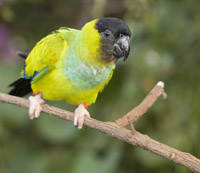


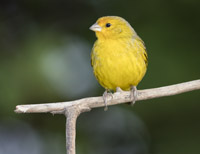
After breakfast we headed out on another game-drive, and encountered about 25 White-lipped Peccaries, a slightly larger and far more aggressive species. Our guide – a great one – circled around in the forest to try to shoo them our way, and actually had a confrontation with some before they backed off. We missed one beautiful scene where the Peccaries were back-lighted and close, but we didn’t stop in time, but we did well with this animal as they ran across various clearings. In our last encounter the Peccaries were close, and apparently agitated, as they exuded a pungent musk – very oily, very pronounced – that lingered in the clearing long after the Peccaries had gone passed.

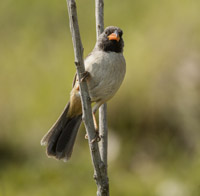 Our guide, Fabiano, speaks very little English but is a very hard worker, trotting or running through the forest to head-off the peccaries. He’s a big guy, with Obama-like ears projecting out from beneath a baseball cap he wears backwards and tilted to the side, and doesn’t say much. As he prepared to go into the brush he took out his gaucho-style knife, worn tucked into the back of the pants, to, I think, sharpen a stick as a protective measure in case these aggressive relatives of the pig did get confrontational.
Our guide, Fabiano, speaks very little English but is a very hard worker, trotting or running through the forest to head-off the peccaries. He’s a big guy, with Obama-like ears projecting out from beneath a baseball cap he wears backwards and tilted to the side, and doesn’t say much. As he prepared to go into the brush he took out his gaucho-style knife, worn tucked into the back of the pants, to, I think, sharpen a stick as a protective measure in case these aggressive relatives of the pig did get confrontational.
We had several Tamanduas, including one very tolerant one in the open where I quietly stepped and crawled in close, close enough to do video with a 7D and 24mm lens where the Tamandua walked within 18 inches of me. I tried getting close to a Giant Anteater at the same location, but only managed about 18 feet.
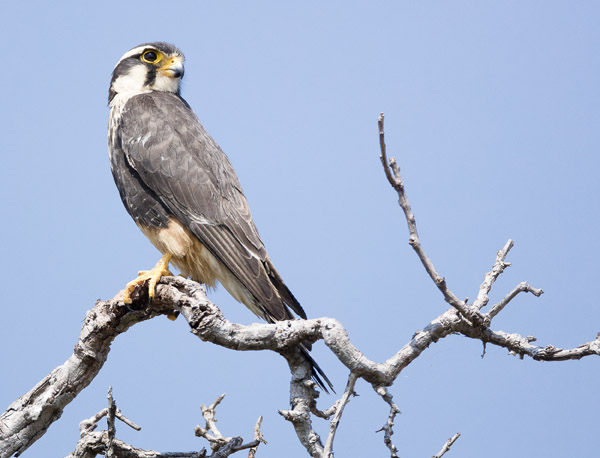
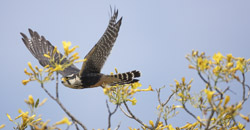
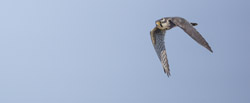
One of the other highlights was a very cooperative Aplomado Falcon, a bird I’ve seen maybe half a dozen times but never photographed. This one was tolerant, and, in fact, as I approached it when still at a distance the bird took off and landed in a closer tree. Later, it flew again, to an even better perch, and all of us got shots as the bird perched cleanly against a blue sky.
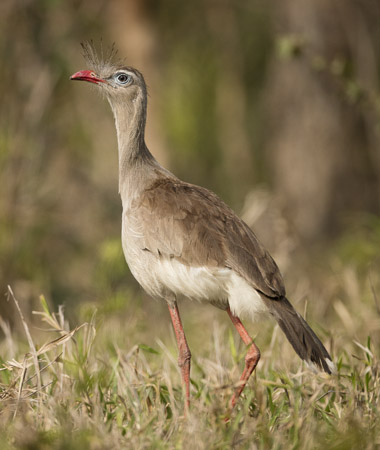 PM. We searched for mother Anteaters with babies, but without success. However, more great shooting, of Red-legged Seremias, Nine-banded Armadillos, Savannah Hawks, Jabiru Storks, Pampas Deer, and Giant Anteaters at the end of the day. We wanted to get a Giant Anteater in a completely natural habitat – no farm fences – and we did, although in this tussock-like grass habitat openings were more difficult.
PM. We searched for mother Anteaters with babies, but without success. However, more great shooting, of Red-legged Seremias, Nine-banded Armadillos, Savannah Hawks, Jabiru Storks, Pampas Deer, and Giant Anteaters at the end of the day. We wanted to get a Giant Anteater in a completely natural habitat – no farm fences – and we did, although in this tussock-like grass habitat openings were more difficult.
What is truly amazing about this place is as we were moving in on one Giant Anteater, we saw another not too much further away, and a large Tamandua that walked right by our guide, and us. In the North, finding any of these animals would be a trip highlight, while here … it is almost commonplace. Towards the end of the day the two Giant Anteaters met up, sniffing with their elongated snouts, twice, before moving their separate ways. Our guide, in Portugese, told me that sometimes great fights result, with roars and the two standing upright, hugging or swatting. We were tempted to shoot video, but if something like that happened, we’d want stills! We shot the anteaters until the light faded, minutes before sunset.
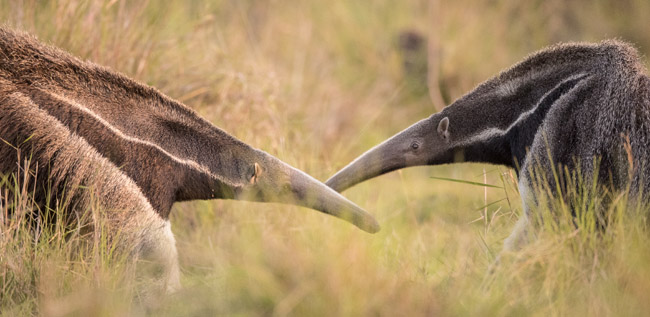
Day Four. Our First Location to Jardem and Gorge of the Macaws
We were told our bus driver would arrive by 7 or 8 AM, and indeed he did, but we didn’t know it and he was sleeping in his bus – a more than adequate size one for our journey. Nonetheless, we got everything sorted out, did a little bird shooting around the feeders, and left at around 9AM for the drive. We met our new guide in Jardem, had a typical Brazilian barbeque with enormous quantities of meat, and at 2PM headed to the Gorge.
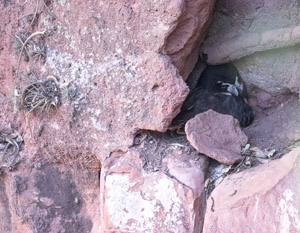 Red and Blue Macaws were flying about, and we quickly moved to the western side of the gorge for over-the-shoulder lighting. Our guide pointed out a Spectacled Owl nesting in a small hole in the gorge wall, a first for me (lifer) and so unexpected in that habitat. By 5PM the light had left the gorge completely and the surrounding trees blocked any sunlight hitting the walls or trees on the sun-lit side, and we wrapped it up, returning to Jardem by 5:45PM for a lighter dinner of pizza. Everyone enjoyed the gorge, the birds, and the challenge of shooting them in flight here.
Red and Blue Macaws were flying about, and we quickly moved to the western side of the gorge for over-the-shoulder lighting. Our guide pointed out a Spectacled Owl nesting in a small hole in the gorge wall, a first for me (lifer) and so unexpected in that habitat. By 5PM the light had left the gorge completely and the surrounding trees blocked any sunlight hitting the walls or trees on the sun-lit side, and we wrapped it up, returning to Jardem by 5:45PM for a lighter dinner of pizza. Everyone enjoyed the gorge, the birds, and the challenge of shooting them in flight here.
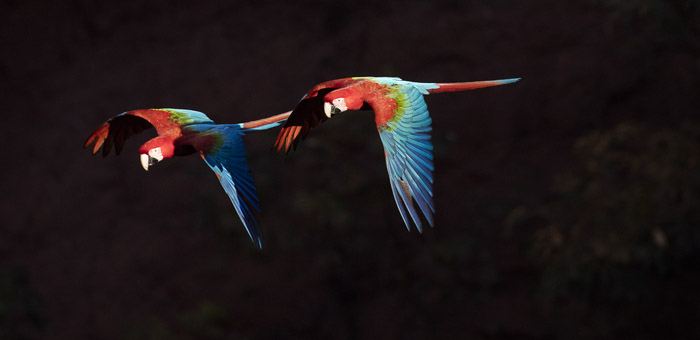
Day Five. Gorge of the Macaws to Faz. San Francisco
We arrived at the Gorge at 7:40AM, long after sunrise but planning to arrive as sunlight entered the top of the gorge, with the bottom still in deep shadow. Another 15 minutes may have been helpful, but most of the canyon walls were still in shadow but the birds were remarkably inactive. We had a few flocks take off and fly about, but nothing truly spectacular, and we felt yesterday’s afternoon shooting was far better. I did one wide-angle with a 16-35mm and, when packing up, apparently left it on the bench. Another group of Americans were there, folks I know, and at this point I’m just hoping they noticed the lens, put two-and-two together, and took the lens with them. If so, perhaps I’ll see it again. Incredibly stupid on my part!
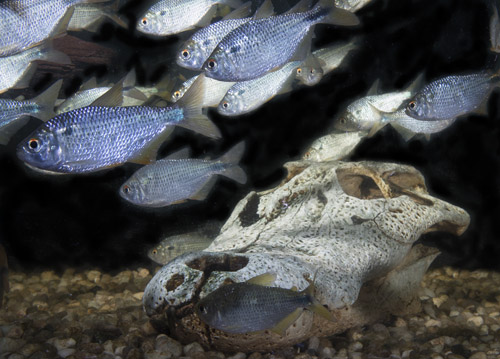 By 9:30 the activity had slowed to a stop, although Blue and Gold Macaws, and Red and Blue Macaws, were still about. We had had some play/courtship activity, with pairs hanging upside down, sometimes pawing each other, sometimes grooming, wings flapping like fruit bats, but all of this activity was either in poor light or obscured by foliage. Our best shots were the birds, Red and Blues, that flew in to the nearest perches, giving us full-frame shots.
By 9:30 the activity had slowed to a stop, although Blue and Gold Macaws, and Red and Blue Macaws, were still about. We had had some play/courtship activity, with pairs hanging upside down, sometimes pawing each other, sometimes grooming, wings flapping like fruit bats, but all of this activity was either in poor light or obscured by foliage. Our best shots were the birds, Red and Blues, that flew in to the nearest perches, giving us full-frame shots.
We headed on to Bonito, a beautiful touristy town, where we had lunch – filet mignon parmesan or chicken parmesan- Cindy’s solo portion would have fed two, and did. Wandering the tourist shops for a short time, while our driver gassed up and ate lunch, I found a large painting of MY BBC Jaguar photo, this time reversed, but an exact copy except for the birds painted in the background. To the artist’s credit he did a really great job – I shot a photo of it with the cell phone.
We arrived at Faz.SF around 3PM, in a heat wave, and trashed our rooms unpacking. The rooms are huge, with one king and two single beds per room, and right now all of my gear is laid down, ready to be sorted for packing to go home. A game-viewing truck filled with tourists passed, kicking up a cloud of dust, and tonight we’ll be sharing a regular tourist truck – it should be a nightmare.
PM.
At 6PM we were scheduled for the tourist bus, and prior to its departure we were treated to skeins of White-faced Ibises, by the hundreds, flying overhead and against the western sky. We wondered where they were all coming from, although with the extensive rice fields of Faz.SF we suspected they were from nearby.
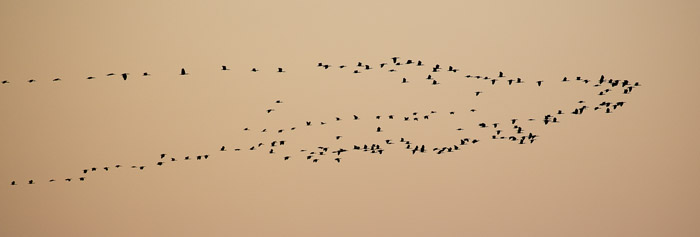
Shortly after 6 we boarded the tourist bus, among the last to do so, but fortunately the first two rows of seats were empty and we had good seating. The photography was virtually non-existent, but for wildlife viewing it was great. Our guide, with 16 years experience, had only seen two Jaguars in his life, but today he saw his next two! One was drinking, in a small opening in a woodlot, and it was tempting enough that I tried a photo. Unfortunately, I was using the 5Dsr where the ISO only goes to 6400 and my shot, at 1/8th sec. was a blur. Had I had the 1DX MII, I’d have been ten times that ISO and maybe had a decent record shot. Later, quite close to the lodge, we had a second Jaguar, running ahead on the game track before disappearing into the woods. We also had three Ocelots, one quite close, that spent most of its time around a truck bed, where it climbed into the axle area, presumably looking for mice nests. We returned to the lodge at 8PM, and at 8:30 there was a special barbeque, but Cindy and I were still quite full from lunch and skipped dinner. Jim went, and had a great time, but didn’t return to his room until 10PM, and to bed until 11, two hours after I was sound asleep!
Day Five. Faz.SF
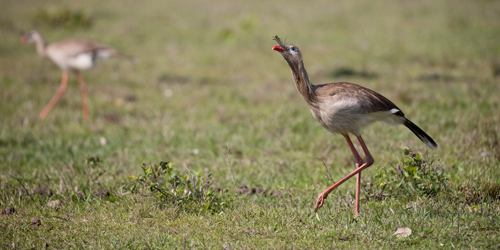
We had a 6AM breakfast and a 6:30AM departure on a well-outfitted safari vehicle, with a row for each of us and another for our guide, Andre’, in the back. We searched for giant anteaters first, without luck, before heading towards the rice fields. En route, we had another Aplomado Falcon, perched in a nice spot but in bad light. Andre said we could drive a nearby road for another view, which I nixed, explaining that we’d then be on the wrong side of the light and would be wasting time when we already had a great 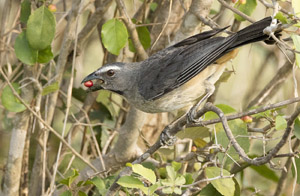 shooting experience at P.A.
shooting experience at P.A.
This does point out something I don’t say enough about, and that’s experience, and an awareness of time management. Mary and I are very aware of our time, and our chances for things, and we try not to waste people’s time on subjects that they already have better, or will get better later on. I’m prompted to say this because in the northern Pantanal we met a group that really illustrates the difference here.
It was nearly dark, and we were still in the rainy, dreary weather we’d had for days, when we saw several photographers ahead of us, obviously intent on shooting something. They appeared to be stalking, and seemed quite cautious. Our group was in a safari vehicle, and as we approached I was afraid that the noise of our truck might spook what I suspected was a tapir or a giant anteater that they were working on. Imagine my surprise when we found they were devoting so much effort, in near darkness, to a group of Capybaras just lying in the grass. Capybaras are abundant here, and seen virtually daily, and we did find it humorous that they were so intent on this. Granted, I’m sure it was their first Capybaras and they were excited, but as a guide, I’d have said, ‘let’s not waste time on this, you’ll get dozens. Instead …’ either let’s look for the rare subjects found here, or just get back to the lodge (it was nearly dark) and unpack, or relax, or download images. At any rate, do something productive!
Local guides will do whatever you want … they are there for you, and they are reluctant to tell clients what to do. An experienced leader would or should know that better opportunities await, or, conversely, ‘this is the moment’ and one should stay with a subject as it may never been seen again. I’ve seen too many ‘photo leaders’ guiding, who are simply relying on the guidance of their local guides, and consequently really selling their group short. I guess you get what you pay for.
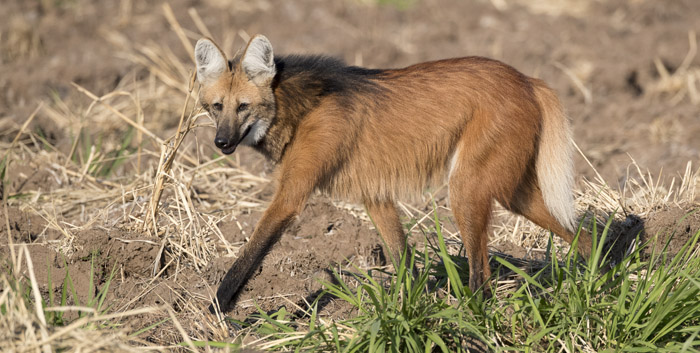
At any rate, perhaps because we did not waste time on a distant falcon we soon encountered an animal my local guide had seen only once, and only at night, and the animal that, when I asked what animal he still most wants to see, he identified as this one. It was a Maned Wolf which our safari-vehicle driver spotted, about 80 yards away, facing us. Incredibly, as we watched, the Wolf (really a canine in its own genus and resembling a fox on stilts) began walking towards us, eventually literally filling the frame with our lenses. It was an incredible opportunity, and only in the northeastern section of Brazil had I ever seen Wolves, and those were at night, at a baited site. This was incredible!
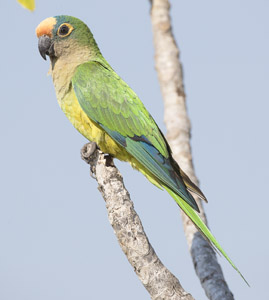 Other highlights for the morning game drive included great shots of Savannah Hawks, Snail Kites, Marsh Deer, Yellow Armadillo, Peach-fronted Parakeets, and Capybaras (with young riding the adult male’s back), and a semi-albino Southern Lapwing. Besides the Wolf, however, our other true highlight was the family of Greater Rheas and a Giant Anteater – both in the same frame, and later, great shots of the Anteater next to an iconic, clay-colored termite mound. We returned to the lodge at 10:30 – a great morning!!!!
Other highlights for the morning game drive included great shots of Savannah Hawks, Snail Kites, Marsh Deer, Yellow Armadillo, Peach-fronted Parakeets, and Capybaras (with young riding the adult male’s back), and a semi-albino Southern Lapwing. Besides the Wolf, however, our other true highlight was the family of Greater Rheas and a Giant Anteater – both in the same frame, and later, great shots of the Anteater next to an iconic, clay-colored termite mound. We returned to the lodge at 10:30 – a great morning!!!!
PM. We left at 3PM for an afternoon game drive focused on finding an Anteater with a baby. We found one, or perhaps two, but in both cases the mother was very shy. We circled the first one with the truck, but at 100 yds or so she retreated into heavy cover. Later, perhaps the same one, we found in the same field, and tried approaching on foot. Again, she took off, and my guide and driver tried circling around to look for her, while I flanked them and Cindy and Jim stayed in a position out in the field where we originally spotted the pair. Eventually the mother came out, at a run along the fence line, and both Cindy and Jim got shots, but it was fast and the baby was facing the wrong side, so the experience was marginal. However, we at least cracked this nut and hopefully we’ll have better luck tomorrow.
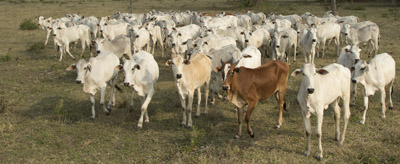 Otherwise, we did have a good shooting opportunity with a Crab-eating Fox and Smooth-billed Anis, and the iconic white cattle in a field dotted with brick-colored termite mounds, some half as tall as the cows. We decided to eat first, and then game-drive, so we’ll see what magic this night will hold.
Otherwise, we did have a good shooting opportunity with a Crab-eating Fox and Smooth-billed Anis, and the iconic white cattle in a field dotted with brick-colored termite mounds, some half as tall as the cows. We decided to eat first, and then game-drive, so we’ll see what magic this night will hold.
Night Game Drive: We had dinner first, then left around 7:30PM and had traveled for only a few minutes when we saw our first Giant Anteater – a mother with a baby on her back! She was close to one of the wire fences, and the grass was high, but as we moved our vehicle to a better position she 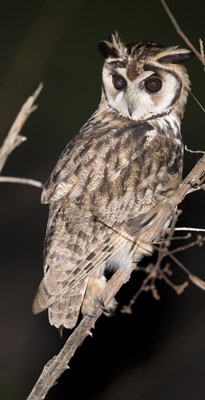 moved out into the open grassland and we managed several fairly good shots. A short time later we had a perfectly clear view of another Giant Anteater digging along a fence line, and still another in an open field, where every claw was visible.
moved out into the open grassland and we managed several fairly good shots. A short time later we had a perfectly clear view of another Giant Anteater digging along a fence line, and still another in an open field, where every claw was visible.
We continued, and soon had our first of two Striped Owls. This one was a bit further away, but closer than I’ve had before, and towards the end of our drive we had another that with my 800 it filled the frame. This was the first time I’ve tried using a big lens on a night drive, thinking it would be too cumbersome or difficult to focus, but it was not, and with a tele-flash I had wonderful light.
We had one Ocelot, sitting in a small opening in a corn field, but it squinted with the lights and we left it after a few shots. Our other great subject was a Paraque nightjar, which we approached on foot, as our vehicle headlights kept us out of view. We had frame-filling shots of this bird as it perched on the road, and tonight we saw several, but only a few Lesser Nighthawks, which we had in abundance on the previous night drive.
Out in the rice paddies we had several buck Marsh Deer and two does, and one of the bucks trailed behind the doe, sniffing, as she ignored him. All of these bucks had their velvet stripped clean, while others I’d seen earlier still had velvet, so I’m wondering if their antler cycle might be more like India’s Spotted Deer, that have babies, and various stages of antler growth, throughout the year.
We returned to the lodge around 9:50PM, quite tired from a full day of game-drives, but quite elated, too, with the productivity we’ve had.
Day Six. Faz. SF
We left at 6:30 for our morning game drive with suspicious-looking clouds on the northwestern horizon, and I worried that another cold front (wrong direction) or bad weather might be approaching. Within an hour those clouds were burned off and the morning was clear, although a few high clouds softened the light a few times. It was, however, a great morning.
We started in farm fields – an odd choice, I felt, but I know the guides know where everything is, so I wasn’t concerned – and while stopping for a doe Marsh Deer another Maned Wolf appeared in the gully below us. It was unconcerned and walked off, into a corn field where it finally bedded down. We got some shots, but we weren’t worried, as yesterday’s were so much better.
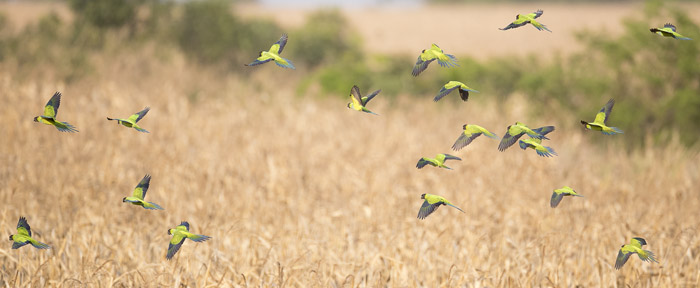
Flocks of Monk Parakeets and Black-hooded Parakeets swept over the cornfields, flying up as we approached, reminding me of our North American, and extinct, Carolina Parakeet that was wiped out because of its threat to crops in 1800 America. Monk Parakeets, introduced and feral in the US, were feared to become like the Starlings (another introduced species) and become a crop pest, but their numbers never took off. In Argentina, where they are native, they are a serious pest.
This morning was a bird morning, in spades. We had great shots of Black-collared Hawks (perched), Snail Kites, Roadside Hawks, and the best I’ve ever had of Crane Hawks. One very cooperative Burrowing Owl, and great shots of a Forked-tailed Flycatcher. Other birds included White-headed Marsh Tyrant, Pale-legged Hornero, Neotropical Cormorant, Maguiri Stork, Brazilian Teal, Green Kingfisher, Black-collared Seedeater, Black Grassquit, Crested Caracara, Barred Antshrike, Tody Flycatcher, White-winged Mockingbird (? Check) and Chaco Chachalaca – and I’m sure I’m missing a few.

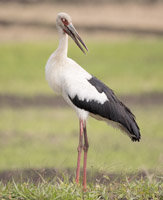
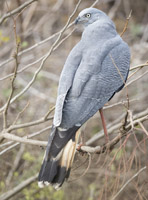
Black-collared Hawk, Maguari, Crane Hawk
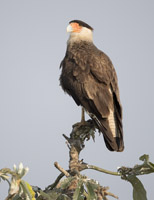

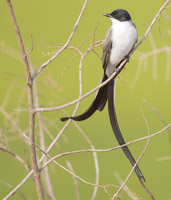
Crested Caracara, Grayish Saltator, Fork-tailed Flycatcher
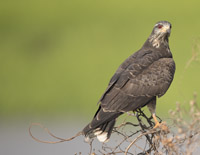
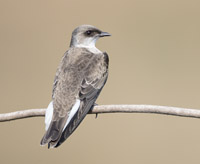
Snail Kite, Brown-chested Martin
.jpg)
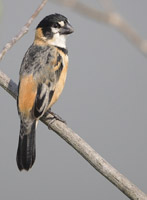
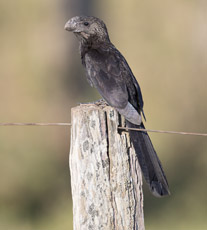
Barred Antshrike, Rufous-collared Seedeater, Smooth-billed Ani
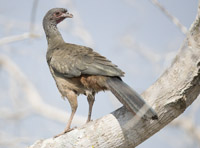
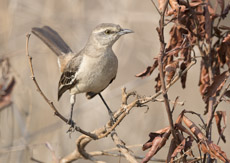
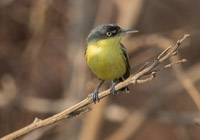
Chaco Chachalaca, White-banded Mockingbird, Common Tody-Flycatcher
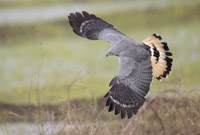
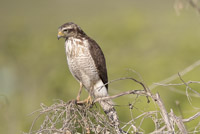
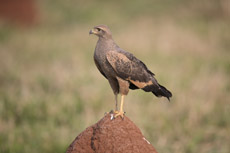
Crane Hawk, Roadside Hawk, Savannah Hawk
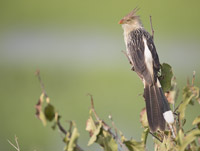
Guira Cuckoo
By 10AM the bird activity had subsided and we started back, following a long canal that led us to the lodge by 10:30.
PM. Humidity was high and with the heat we decided to leave at 4PM, devoting our time to searching for the elusive mother Giant Anteater and baby. We drove the main ranch road to the highway and back, stopping for two nice Savannah Hawks, one so close that the termite mound it perched on was just a brown knob, but the other, further away, gave the entire scene – the full mound and the bird. Our driver-guide either heard (Cindy described the call as ‘sweeter’) or saw a pair of Golden-collared Macaws in a bare tree, with plenty of limbs obscuring the birds but fortunately they flew off and landed in another tree which gave us a great view. We saw several anteaters, but all were alone.
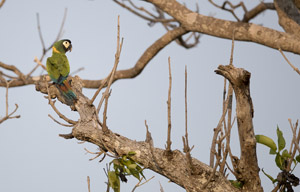
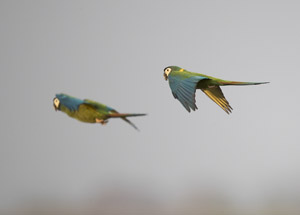
In the distance, to the west and on a small rise, I noticed a Greater Rhea flaring its wings. I thought it was in display, but as we watched I saw that Southern Lapwings were dive-bombing the bird. Against the golden light the fluffy wings were wonderfully back-lighted, and we turned off the main road to get closer. Although the Lapwing attack stopped, we found that the male Rhea had about a dozen young chicks, naked-looking with their thin coat of down, surrounding him, and in the soft backlighting the shots were great.
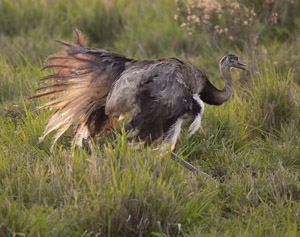
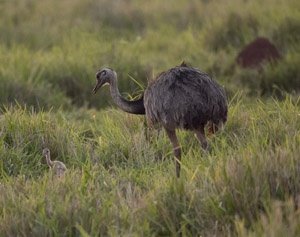
We continued back to the main road, and another Giant Anteater crossed in front of us – this one with a baby on her back. She was headed to a fence line and thick brush, and our two guides rushed out and headed for the brush as well. The Anteater stopped, and at that point I climbed out of the truck to try for some shots in the high grass. Fortunately, unlike with the Tamandua, this time I grabbed the right lens, and I left the tripod behind, which certainly increased my mobility.
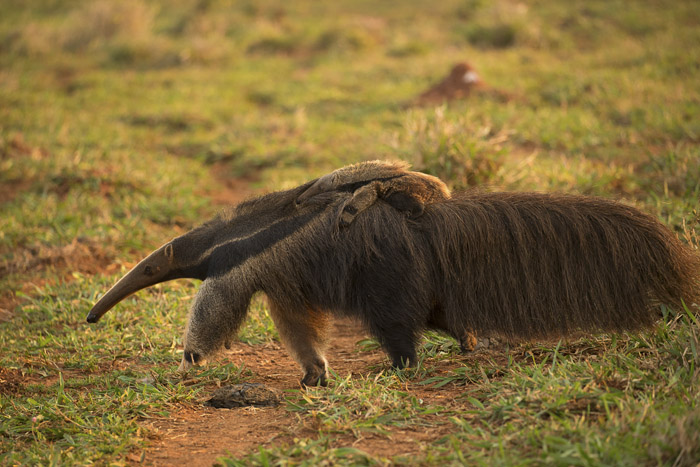 The Anteater did a 180, and crossed the road again, giving Jim and Cindy an opportunity to shoot, but just like last evening’s baby, the young one was facing the opposite way. I circled behind, trying to keep some distance so that I wouldn’t spook the anteater into running off. It went under a fence, and I, further to the north, went through one. The Anteater seemed to be headed for a distant woods, but was slowing down a bit – and although their eyesight is poor, this mother seemed to know I was there. The wind was blowing her way, and they are acutely aware of scent. I tried jogging ahead, weaving around tussock grasses and watching my step, as I’m always wondering about snakes, especially tropical rattlesnakes in this habitat, and eventually I got a few meters ahead. In front of me there was a dirt track, free of grass, and the Anteater was headed that way to cross. I took several breaths and willed myself to calm down and get steady, checked my exposure against the grass, and seconds later the Anteater crossed, with the baby facing me. Passing by, with no other opening in sight, I returned to the road.
The Anteater did a 180, and crossed the road again, giving Jim and Cindy an opportunity to shoot, but just like last evening’s baby, the young one was facing the opposite way. I circled behind, trying to keep some distance so that I wouldn’t spook the anteater into running off. It went under a fence, and I, further to the north, went through one. The Anteater seemed to be headed for a distant woods, but was slowing down a bit – and although their eyesight is poor, this mother seemed to know I was there. The wind was blowing her way, and they are acutely aware of scent. I tried jogging ahead, weaving around tussock grasses and watching my step, as I’m always wondering about snakes, especially tropical rattlesnakes in this habitat, and eventually I got a few meters ahead. In front of me there was a dirt track, free of grass, and the Anteater was headed that way to cross. I took several breaths and willed myself to calm down and get steady, checked my exposure against the grass, and seconds later the Anteater crossed, with the baby facing me. Passing by, with no other opening in sight, I returned to the road.
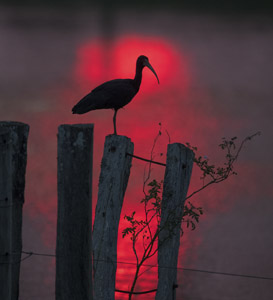 It was nearly dusk and we headed back towards the lodge – I was hoping we would get to the cell tower hill for a better vantage for the skeins of Bare-faced Ibis that would be flying by, but the sun was sinking into a dusky murk. We stopped on the main road where the reflection of a fireball sun backlighted an Ibis on a fencepost – I got out of the truck again for a better angle, standing just eight feet from a Capybara that was lying, Sphinx-like, just six feet away. Lines and lines of Ibis flew by in the distance, and Cindy did a lot of pattern shots of the birds – straight lines, clumps, Vs, and combos of all, and I did some video. With the light finally dying – the sun was so murky that it appeared to be a lighter-colored cloud, we headed back to the lodge to regroup, pack, and get ready for our final night drive.
It was nearly dusk and we headed back towards the lodge – I was hoping we would get to the cell tower hill for a better vantage for the skeins of Bare-faced Ibis that would be flying by, but the sun was sinking into a dusky murk. We stopped on the main road where the reflection of a fireball sun backlighted an Ibis on a fencepost – I got out of the truck again for a better angle, standing just eight feet from a Capybara that was lying, Sphinx-like, just six feet away. Lines and lines of Ibis flew by in the distance, and Cindy did a lot of pattern shots of the birds – straight lines, clumps, Vs, and combos of all, and I did some video. With the light finally dying – the sun was so murky that it appeared to be a lighter-colored cloud, we headed back to the lodge to regroup, pack, and get ready for our final night drive.
Night Drive – we left at 7:30, and I think the drivers were looking for cats as we headed straight to the canals bordering the forest. At a pumping station, where red lights on a control panel glowed like giant eye shine, a Jaguar popped out on the road in front of us – thirty feet away. It trotted down the road and our driver raced after it, with us bumping too much to 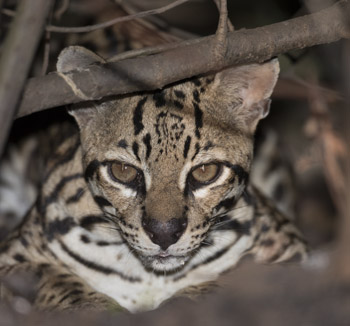 get a lens on the cat. I commented later that I thought it would have been better to stop a moment and watch, perhaps the cat would have turned to look, but our guide said they just keep running. At any rate, it went down an embankment, turned to face us – we all missed the shot – and swam across a small pond and disappeared into the forest. With the high grasses, limited windows, and bumpiness, I never got a clear shot of the head. Still, it was our third Jaguar for here, and our guide, with 16 years experience, had only seen four before these three he saw with us.
get a lens on the cat. I commented later that I thought it would have been better to stop a moment and watch, perhaps the cat would have turned to look, but our guide said they just keep running. At any rate, it went down an embankment, turned to face us – we all missed the shot – and swam across a small pond and disappeared into the forest. With the high grasses, limited windows, and bumpiness, I never got a clear shot of the head. Still, it was our third Jaguar for here, and our guide, with 16 years experience, had only seen four before these three he saw with us.
We had another Ocelot, but so well concealed I never saw it, and another, later, that sat beneath a bush so close that I did headshots (I had the 800, the other’s 100-400s). We had a third, on a dike that I first thought was a fox, and I barely had time to raise the lens before it got up, walked across a small opening, and dropped out of sight. It was carrying a rat in its jaws – I missed sharp focus on the best shots – milliseconds of shooting.
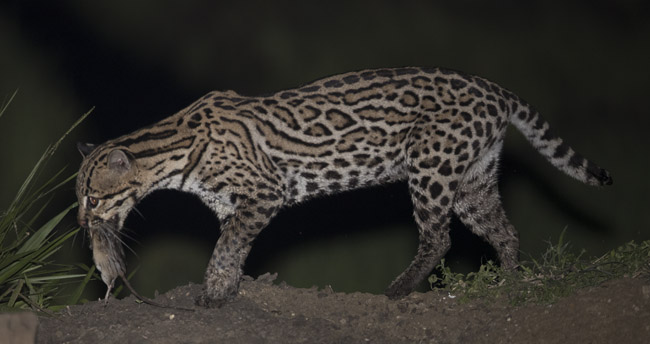
We had another great Marsh Deer – this one, portrait head shots, and a Crab-eating Raccoon – our first for this trip – that was foraging in the rice fields. We finished the evening with another Giant Anteater right beside the road, huffing and blowing as it dug at ants or termites along the fence line, oblivious to us and the spot light less than thirty feet away. We returned to the lodge by 9:45, still to pack for the trip home.
Day Seven. Faz. SF to Campo Grande
In all, here at SF we had 3 Jaguars, 6-7 Ocelots, at least a dozen Giant Anteaters, and a wealth of birds – probably shooting at least twenty yesterday alone. At PA we had at least two dozen Anteaters, probably 8 Tamanduas, both species of Peccary, Pampas Deer, and more birds at their feeder. The southern Pantanal was, for both Cindy and Jim, far more than they ever expected, so mammal-rich and diverse, with a great infrastructure, and all of us were a bit sad one, that it was time to leave, and two, that others from the Jaguar trip did not join us here. It is a terrific place.
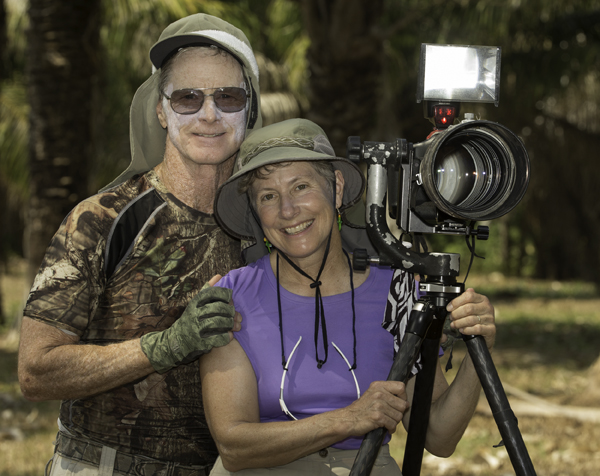
Join us in the Southern Pantanal in 2018 -- we may do two trips like the one described above. This is a spectacular location, with great opportunities to be on-foot and working close with wildlife. I love this place!
Check out OUR 2015 Trip Report, or check out all our Trip Reports for the Jaguars and the Pantanal.
Read our 2016 brochure (until I get a chance to update the brochure!) Information applies for 2017, for reference, although exact dates and prices will differ.








Sign up for our Constant Contact Newsletter to receive the latest information on our up coming tours and safaris, immediate opening offerings, and other news. We do not share this list with any other source.
Join us on Facebook at: Follow Hoot Hollow
Wildlife
of the
Southern Pantanal
Photo Tour
September 2016
Trip Report



Day One. We arrived in Campo Grande at 10:30PM, after a long day of travel that began with our bus ride to Cuiaba at 6AM. We didn’t arrive at our lodge, P A, until 1:45AM, and to bed by about 3AM. A long day, with dreary skies but no rain.
Day Two. Our First Location.
 I awoke at 7:20, although earlier the birds and the staff had me awake, but the rest was good and we were rewarded with sunny skies! At breakfast we had several new birds, Giant Cowbirds, Plumbed Jays, and the usual, and at 9AM we did a walk for wildlife. All of us carried 100-400 or equivalents, and I was happy I did, as the 800mm would have been heavy, cumbersome, and, ultimately, not needed for the highlight of the morning.
I awoke at 7:20, although earlier the birds and the staff had me awake, but the rest was good and we were rewarded with sunny skies! At breakfast we had several new birds, Giant Cowbirds, Plumbed Jays, and the usual, and at 9AM we did a walk for wildlife. All of us carried 100-400 or equivalents, and I was happy I did, as the 800mm would have been heavy, cumbersome, and, ultimately, not needed for the highlight of the morning.
After seeing and photographingWhite Woodpeckers, Bare-faced Ibis, Burrowing Owls, etc., we found a Giant Anteater that we spent nearly an hour with. We kept downwind, and we were quiet, and often the Anteater walked within frame-filling distance of a 300mm. It was great shooting, which we abandoned around 11AM as the sun was high, and we had shot A LOT of anteater images!

 PM. We saw at least 9 Giant Anteaters this afternoon but the morning shoot was so good we passed on every one of them. This is unheard of!!! However, we were after ‘bigger’ game, hoping to get a mother with a baby on her back. We did not, but the day was nonetheless a stellar one.
PM. We saw at least 9 Giant Anteaters this afternoon but the morning shoot was so good we passed on every one of them. This is unheard of!!! However, we were after ‘bigger’ game, hoping to get a mother with a baby on her back. We did not, but the day was nonetheless a stellar one.
Shortly after starting our game drive we had the first of 3 Tamanduas, or Lesser Anteaters. This animal has poor eyesight, and we were careful to be relatively quiet except for the click of our shutters, and at times the Tamandua walked within ten feet of us. I was glad that this time (unlike my first Jaguar Trip this year!) I had the correct lens. We actually had a choice – going for the Tamandua or a 9-banded Armadillo, but as it turned out, after doing the Tamandua we did the  Armadillo, and did well. At lunch, by the way, I photographed a pair of 6-banded, or yellow, Armadillos right beside our dining area, while we ignored the five Coatimundis that were walking around the grounds.
Armadillo, and did well. At lunch, by the way, I photographed a pair of 6-banded, or yellow, Armadillos right beside our dining area, while we ignored the five Coatimundis that were walking around the grounds.
Soon after the Armadillo we found the first of several Pampas Deer, and our great local guide drove the vehicle onto the correct side, sunlit, for nice  shots of the doe. After that, we found a male with his antlers in velvet, and while doing for him spooked a mother Jacare’ Caiman with babies on her back from the track. She did not return to her sunning spot when we returned, after photographing the deer.
shots of the doe. After that, we found a male with his antlers in velvet, and while doing for him spooked a mother Jacare’ Caiman with babies on her back from the track. She did not return to her sunning spot when we returned, after photographing the deer.
We continued, photographing another Tamandua, some birds, a nice ‘herd shot’ of Capybaras from an aerial perspective, and a Greater Rhea, and ending at a Caiman pond where we photographed Caiman feeding on fish with our wide-angle lenses – less than three feet away. Cindy  couldn’t believe she was this close to a wild crocodilian. It was fun.
couldn’t believe she was this close to a wild crocodilian. It was fun.
The afternoon passed rapidly and we headed back towards the lodge, stopping with the last light of the day for another Tamandua. This one, perhaps because it was near dusk and predators are about, spooked at one point and stood up, arms outstretched in its defensive posture. I videoed and shot the pose. While there, a Collared Peccary trotted by – our 7th mammal species for the day. We had more mammal shooting (other than  jaguars and giant otters) here in one day than in an entire trip in the northern Pantanal. We will return here, to be sure!
jaguars and giant otters) here in one day than in an entire trip in the northern Pantanal. We will return here, to be sure!
At dinner, the Crab-eating Fox arrived looking for handouts. I had brought along 7 Phottix Ares transmitter/receivers that I had hoped to use with the Ocelot in the northern Pantanal, but the fast movement, and fleeting poses of that animal made sharing flashes via the Phottix impossible. However with the Fox it was different, as the Fox held poses for minutes at times, and with only three shooters using the Ares it was easy to fire away. The multiple lighting eliminated all red-eye problems, and varied the lighting nicely, making the end of a very good day – at least 7 different mammals photographed.
Side Note: Our driver to this lodge was/is a guide for 16 years, and as I usually do with guides, I asked him what the most exciting or interesting thing he’s ever seen. Here is his, and it is unique: He was watching a Brazilian Tapir and Yellow-headed Caracaras, and the Caracaras began making their whistling noise or call. The Tapir appeared out of the brush and whistled back, a deeper, stronger whistle, but what the guide described as a whistle. The Caracaras responded. All this is just coincidence at this point. Then the Tapir laid down on its side, I think still whistling, and the Caracaras hopped down and proceeded to pick ticks (he supposes) off the belly and sides of the Tapir. To him, as he describes it, it was like, ‘hey, caracaras, I have ticks here. Help me out, take these ticks,’ or perhaps, ‘Hey, tapir. Do you have any ticks? Can we eat them?’ Either way, he said there is no way he is not convinced that the tapir and the caracaras were in communication. Why not? Various reef fish signal groomer fish like gobis that they are at the reef to be groomed, and instead of eating these little fish they placidly let themselves be picked clean of parasites. For fish, as far as we know, this signal is visual (but who knows what else might be going on?), but for birds and mammals, this signal could be, and probably is, audio or visual, or both.
Side Note 2: This lodge was well known for the Ocelots that visited a fishing camp nearby, where fishermen gave the Ocelots scraps. This was so reliable that it was a photo destination, and almost a sure-thing for Ocelots. Tonight, I asked an acquaintance I met here whether or not he was going to visit the Ocelot Fish Camp. He called over his guide, and asked him to listen to me. Instead, I found out that supposedly baiting or feeding ocelots was illegal, and this was reported. Wildlife officials arrived, and supposedly threatened to close down this lodge! At any rate, all feeding stopped; rumor has it that the Ocelots were captured and transported elsewhere (a virtual death sentence), but the feeding station is gone. Which makes me wonder what the long-term viability of the Ocelot baiting station in the northern Pantanal will be? Supposedly, only baiting pumas and jaguars is prohibited, but again, rumor has it that there is a lot of envy and jealousy about this bait station. I wonder if it will even be available next year.
Day Three. Our First Location
Another incredible day. We started with a bird shoot around the breakfast area, where scores or more of Black-hooded Parakeets swarmed in to the feeders, with Plum-crested Jays, Saffron Finches, Giant Blackbirds, and both species of Cardinals joining in.




After breakfast we headed out on another game-drive, and encountered about 25 White-lipped Peccaries, a slightly larger and far more aggressive species. Our guide – a great one – circled around in the forest to try to shoo them our way, and actually had a confrontation with some before they backed off. We missed one beautiful scene where the Peccaries were back-lighted and close, but we didn’t stop in time, but we did well with this animal as they ran across various clearings. In our last encounter the Peccaries were close, and apparently agitated, as they exuded a pungent musk – very oily, very pronounced – that lingered in the clearing long after the Peccaries had gone passed.

 Our guide, Fabiano, speaks very little English but is a very hard worker, trotting or running through the forest to head-off the peccaries. He’s a big guy, with Obama-like ears projecting out from beneath a baseball cap he wears backwards and tilted to the side, and doesn’t say much. As he prepared to go into the brush he took out his gaucho-style knife, worn tucked into the back of the pants, to, I think, sharpen a stick as a protective measure in case these aggressive relatives of the pig did get confrontational.
Our guide, Fabiano, speaks very little English but is a very hard worker, trotting or running through the forest to head-off the peccaries. He’s a big guy, with Obama-like ears projecting out from beneath a baseball cap he wears backwards and tilted to the side, and doesn’t say much. As he prepared to go into the brush he took out his gaucho-style knife, worn tucked into the back of the pants, to, I think, sharpen a stick as a protective measure in case these aggressive relatives of the pig did get confrontational.
We had several Tamanduas, including one very tolerant one in the open where I quietly stepped and crawled in close, close enough to do video with a 7D and 24mm lens where the Tamandua walked within 18 inches of me. I tried getting close to a Giant Anteater at the same location, but only managed about 18 feet.



One of the other highlights was a very cooperative Aplomado Falcon, a bird I’ve seen maybe half a dozen times but never photographed. This one was tolerant, and, in fact, as I approached it when still at a distance the bird took off and landed in a closer tree. Later, it flew again, to an even better perch, and all of us got shots as the bird perched cleanly against a blue sky.
 PM. We searched for mother Anteaters with babies, but without success. However, more great shooting, of Red-legged Seremias, Nine-banded Armadillos, Savannah Hawks, Jabiru Storks, Pampas Deer, and Giant Anteaters at the end of the day. We wanted to get a Giant Anteater in a completely natural habitat – no farm fences – and we did, although in this tussock-like grass habitat openings were more difficult.
PM. We searched for mother Anteaters with babies, but without success. However, more great shooting, of Red-legged Seremias, Nine-banded Armadillos, Savannah Hawks, Jabiru Storks, Pampas Deer, and Giant Anteaters at the end of the day. We wanted to get a Giant Anteater in a completely natural habitat – no farm fences – and we did, although in this tussock-like grass habitat openings were more difficult.
What is truly amazing about this place is as we were moving in on one Giant Anteater, we saw another not too much further away, and a large Tamandua that walked right by our guide, and us. In the North, finding any of these animals would be a trip highlight, while here … it is almost commonplace. Towards the end of the day the two Giant Anteaters met up, sniffing with their elongated snouts, twice, before moving their separate ways. Our guide, in Portugese, told me that sometimes great fights result, with roars and the two standing upright, hugging or swatting. We were tempted to shoot video, but if something like that happened, we’d want stills! We shot the anteaters until the light faded, minutes before sunset.

Day Four. Our First Location to Jardem and Gorge of the Macaws
We were told our bus driver would arrive by 7 or 8 AM, and indeed he did, but we didn’t know it and he was sleeping in his bus – a more than adequate size one for our journey. Nonetheless, we got everything sorted out, did a little bird shooting around the feeders, and left at around 9AM for the drive. We met our new guide in Jardem, had a typical Brazilian barbeque with enormous quantities of meat, and at 2PM headed to the Gorge.
 Red and Blue Macaws were flying about, and we quickly moved to the western side of the gorge for over-the-shoulder lighting. Our guide pointed out a Spectacled Owl nesting in a small hole in the gorge wall, a first for me (lifer) and so unexpected in that habitat. By 5PM the light had left the gorge completely and the surrounding trees blocked any sunlight hitting the walls or trees on the sun-lit side, and we wrapped it up, returning to Jardem by 5:45PM for a lighter dinner of pizza. Everyone enjoyed the gorge, the birds, and the challenge of shooting them in flight here.
Red and Blue Macaws were flying about, and we quickly moved to the western side of the gorge for over-the-shoulder lighting. Our guide pointed out a Spectacled Owl nesting in a small hole in the gorge wall, a first for me (lifer) and so unexpected in that habitat. By 5PM the light had left the gorge completely and the surrounding trees blocked any sunlight hitting the walls or trees on the sun-lit side, and we wrapped it up, returning to Jardem by 5:45PM for a lighter dinner of pizza. Everyone enjoyed the gorge, the birds, and the challenge of shooting them in flight here.

Day Five. Gorge of the Macaws to Faz. San Francisco
We arrived at the Gorge at 7:40AM, long after sunrise but planning to arrive as sunlight entered the top of the gorge, with the bottom still in deep shadow. Another 15 minutes may have been helpful, but most of the canyon walls were still in shadow but the birds were remarkably inactive. We had a few flocks take off and fly about, but nothing truly spectacular, and we felt yesterday’s afternoon shooting was far better. I did one wide-angle with a 16-35mm and, when packing up, apparently left it on the bench. Another group of Americans were there, folks I know, and at this point I’m just hoping they noticed the lens, put two-and-two together, and took the lens with them. If so, perhaps I’ll see it again. Incredibly stupid on my part!
 By 9:30 the activity had slowed to a stop, although Blue and Gold Macaws, and Red and Blue Macaws, were still about. We had had some play/courtship activity, with pairs hanging upside down, sometimes pawing each other, sometimes grooming, wings flapping like fruit bats, but all of this activity was either in poor light or obscured by foliage. Our best shots were the birds, Red and Blues, that flew in to the nearest perches, giving us full-frame shots.
By 9:30 the activity had slowed to a stop, although Blue and Gold Macaws, and Red and Blue Macaws, were still about. We had had some play/courtship activity, with pairs hanging upside down, sometimes pawing each other, sometimes grooming, wings flapping like fruit bats, but all of this activity was either in poor light or obscured by foliage. Our best shots were the birds, Red and Blues, that flew in to the nearest perches, giving us full-frame shots.
We headed on to Bonito, a beautiful touristy town, where we had lunch – filet mignon parmesan or chicken parmesan- Cindy’s solo portion would have fed two, and did. Wandering the tourist shops for a short time, while our driver gassed up and ate lunch, I found a large painting of MY BBC Jaguar photo, this time reversed, but an exact copy except for the birds painted in the background. To the artist’s credit he did a really great job – I shot a photo of it with the cell phone.
We arrived at Faz.SF around 3PM, in a heat wave, and trashed our rooms unpacking. The rooms are huge, with one king and two single beds per room, and right now all of my gear is laid down, ready to be sorted for packing to go home. A game-viewing truck filled with tourists passed, kicking up a cloud of dust, and tonight we’ll be sharing a regular tourist truck – it should be a nightmare.
PM.
At 6PM we were scheduled for the tourist bus, and prior to its departure we were treated to skeins of White-faced Ibises, by the hundreds, flying overhead and against the western sky. We wondered where they were all coming from, although with the extensive rice fields of Faz.SF we suspected they were from nearby.

Shortly after 6 we boarded the tourist bus, among the last to do so, but fortunately the first two rows of seats were empty and we had good seating. The photography was virtually non-existent, but for wildlife viewing it was great. Our guide, with 16 years experience, had only seen two Jaguars in his life, but today he saw his next two! One was drinking, in a small opening in a woodlot, and it was tempting enough that I tried a photo. Unfortunately, I was using the 5Dsr where the ISO only goes to 6400 and my shot, at 1/8th sec. was a blur. Had I had the 1DX MII, I’d have been ten times that ISO and maybe had a decent record shot. Later, quite close to the lodge, we had a second Jaguar, running ahead on the game track before disappearing into the woods. We also had three Ocelots, one quite close, that spent most of its time around a truck bed, where it climbed into the axle area, presumably looking for mice nests. We returned to the lodge at 8PM, and at 8:30 there was a special barbeque, but Cindy and I were still quite full from lunch and skipped dinner. Jim went, and had a great time, but didn’t return to his room until 10PM, and to bed until 11, two hours after I was sound asleep!
Day Five. Faz.SF

We had a 6AM breakfast and a 6:30AM departure on a well-outfitted safari vehicle, with a row for each of us and another for our guide, Andre’, in the back. We searched for giant anteaters first, without luck, before heading towards the rice fields. En route, we had another Aplomado Falcon, perched in a nice spot but in bad light. Andre said we could drive a nearby road for another view, which I nixed, explaining that we’d then be on the wrong side of the light and would be wasting time when we already had a great  shooting experience at P.A.
shooting experience at P.A.
This does point out something I don’t say enough about, and that’s experience, and an awareness of time management. Mary and I are very aware of our time, and our chances for things, and we try not to waste people’s time on subjects that they already have better, or will get better later on. I’m prompted to say this because in the northern Pantanal we met a group that really illustrates the difference here.
It was nearly dark, and we were still in the rainy, dreary weather we’d had for days, when we saw several photographers ahead of us, obviously intent on shooting something. They appeared to be stalking, and seemed quite cautious. Our group was in a safari vehicle, and as we approached I was afraid that the noise of our truck might spook what I suspected was a tapir or a giant anteater that they were working on. Imagine my surprise when we found they were devoting so much effort, in near darkness, to a group of Capybaras just lying in the grass. Capybaras are abundant here, and seen virtually daily, and we did find it humorous that they were so intent on this. Granted, I’m sure it was their first Capybaras and they were excited, but as a guide, I’d have said, ‘let’s not waste time on this, you’ll get dozens. Instead …’ either let’s look for the rare subjects found here, or just get back to the lodge (it was nearly dark) and unpack, or relax, or download images. At any rate, do something productive!
Local guides will do whatever you want … they are there for you, and they are reluctant to tell clients what to do. An experienced leader would or should know that better opportunities await, or, conversely, ‘this is the moment’ and one should stay with a subject as it may never been seen again. I’ve seen too many ‘photo leaders’ guiding, who are simply relying on the guidance of their local guides, and consequently really selling their group short. I guess you get what you pay for.

At any rate, perhaps because we did not waste time on a distant falcon we soon encountered an animal my local guide had seen only once, and only at night, and the animal that, when I asked what animal he still most wants to see, he identified as this one. It was a Maned Wolf which our safari-vehicle driver spotted, about 80 yards away, facing us. Incredibly, as we watched, the Wolf (really a canine in its own genus and resembling a fox on stilts) began walking towards us, eventually literally filling the frame with our lenses. It was an incredible opportunity, and only in the northeastern section of Brazil had I ever seen Wolves, and those were at night, at a baited site. This was incredible!
 Other highlights for the morning game drive included great shots of Savannah Hawks, Snail Kites, Marsh Deer, Yellow Armadillo, Peach-fronted Parakeets, and Capybaras (with young riding the adult male’s back), and a semi-albino Southern Lapwing. Besides the Wolf, however, our other true highlight was the family of Greater Rheas and a Giant Anteater – both in the same frame, and later, great shots of the Anteater next to an iconic, clay-colored termite mound. We returned to the lodge at 10:30 – a great morning!!!!
Other highlights for the morning game drive included great shots of Savannah Hawks, Snail Kites, Marsh Deer, Yellow Armadillo, Peach-fronted Parakeets, and Capybaras (with young riding the adult male’s back), and a semi-albino Southern Lapwing. Besides the Wolf, however, our other true highlight was the family of Greater Rheas and a Giant Anteater – both in the same frame, and later, great shots of the Anteater next to an iconic, clay-colored termite mound. We returned to the lodge at 10:30 – a great morning!!!!
PM. We left at 3PM for an afternoon game drive focused on finding an Anteater with a baby. We found one, or perhaps two, but in both cases the mother was very shy. We circled the first one with the truck, but at 100 yds or so she retreated into heavy cover. Later, perhaps the same one, we found in the same field, and tried approaching on foot. Again, she took off, and my guide and driver tried circling around to look for her, while I flanked them and Cindy and Jim stayed in a position out in the field where we originally spotted the pair. Eventually the mother came out, at a run along the fence line, and both Cindy and Jim got shots, but it was fast and the baby was facing the wrong side, so the experience was marginal. However, we at least cracked this nut and hopefully we’ll have better luck tomorrow.
 Otherwise, we did have a good shooting opportunity with a Crab-eating Fox and Smooth-billed Anis, and the iconic white cattle in a field dotted with brick-colored termite mounds, some half as tall as the cows. We decided to eat first, and then game-drive, so we’ll see what magic this night will hold.
Otherwise, we did have a good shooting opportunity with a Crab-eating Fox and Smooth-billed Anis, and the iconic white cattle in a field dotted with brick-colored termite mounds, some half as tall as the cows. We decided to eat first, and then game-drive, so we’ll see what magic this night will hold.
Night Game Drive: We had dinner first, then left around 7:30PM and had traveled for only a few minutes when we saw our first Giant Anteater – a mother with a baby on her back! She was close to one of the wire fences, and the grass was high, but as we moved our vehicle to a better position she  moved out into the open grassland and we managed several fairly good shots. A short time later we had a perfectly clear view of another Giant Anteater digging along a fence line, and still another in an open field, where every claw was visible.
moved out into the open grassland and we managed several fairly good shots. A short time later we had a perfectly clear view of another Giant Anteater digging along a fence line, and still another in an open field, where every claw was visible.
We continued, and soon had our first of two Striped Owls. This one was a bit further away, but closer than I’ve had before, and towards the end of our drive we had another that with my 800 it filled the frame. This was the first time I’ve tried using a big lens on a night drive, thinking it would be too cumbersome or difficult to focus, but it was not, and with a tele-flash I had wonderful light.
We had one Ocelot, sitting in a small opening in a corn field, but it squinted with the lights and we left it after a few shots. Our other great subject was a Paraque nightjar, which we approached on foot, as our vehicle headlights kept us out of view. We had frame-filling shots of this bird as it perched on the road, and tonight we saw several, but only a few Lesser Nighthawks, which we had in abundance on the previous night drive.
Out in the rice paddies we had several buck Marsh Deer and two does, and one of the bucks trailed behind the doe, sniffing, as she ignored him. All of these bucks had their velvet stripped clean, while others I’d seen earlier still had velvet, so I’m wondering if their antler cycle might be more like India’s Spotted Deer, that have babies, and various stages of antler growth, throughout the year.
We returned to the lodge around 9:50PM, quite tired from a full day of game-drives, but quite elated, too, with the productivity we’ve had.
Day Six. Faz. SF
We left at 6:30 for our morning game drive with suspicious-looking clouds on the northwestern horizon, and I worried that another cold front (wrong direction) or bad weather might be approaching. Within an hour those clouds were burned off and the morning was clear, although a few high clouds softened the light a few times. It was, however, a great morning.
We started in farm fields – an odd choice, I felt, but I know the guides know where everything is, so I wasn’t concerned – and while stopping for a doe Marsh Deer another Maned Wolf appeared in the gully below us. It was unconcerned and walked off, into a corn field where it finally bedded down. We got some shots, but we weren’t worried, as yesterday’s were so much better.

Flocks of Monk Parakeets and Black-hooded Parakeets swept over the cornfields, flying up as we approached, reminding me of our North American, and extinct, Carolina Parakeet that was wiped out because of its threat to crops in 1800 America. Monk Parakeets, introduced and feral in the US, were feared to become like the Starlings (another introduced species) and become a crop pest, but their numbers never took off. In Argentina, where they are native, they are a serious pest.
This morning was a bird morning, in spades. We had great shots of Black-collared Hawks (perched), Snail Kites, Roadside Hawks, and the best I’ve ever had of Crane Hawks. One very cooperative Burrowing Owl, and great shots of a Forked-tailed Flycatcher. Other birds included White-headed Marsh Tyrant, Pale-legged Hornero, Neotropical Cormorant, Maguiri Stork, Brazilian Teal, Green Kingfisher, Black-collared Seedeater, Black Grassquit, Crested Caracara, Barred Antshrike, Tody Flycatcher, White-winged Mockingbird (? Check) and Chaco Chachalaca – and I’m sure I’m missing a few.



Black-collared Hawk, Maguari, Crane Hawk



Crested Caracara, Grayish Saltator, Fork-tailed Flycatcher


Snail Kite, Brown-chested Martin
.jpg)


Barred Antshrike, Rufous-collared Seedeater, Smooth-billed Ani



Chaco Chachalaca, White-banded Mockingbird, Common Tody-Flycatcher



Crane Hawk, Roadside Hawk, Savannah Hawk

Guira Cuckoo
By 10AM the bird activity had subsided and we started back, following a long canal that led us to the lodge by 10:30.
PM. Humidity was high and with the heat we decided to leave at 4PM, devoting our time to searching for the elusive mother Giant Anteater and baby. We drove the main ranch road to the highway and back, stopping for two nice Savannah Hawks, one so close that the termite mound it perched on was just a brown knob, but the other, further away, gave the entire scene – the full mound and the bird. Our driver-guide either heard (Cindy described the call as ‘sweeter’) or saw a pair of Golden-collared Macaws in a bare tree, with plenty of limbs obscuring the birds but fortunately they flew off and landed in another tree which gave us a great view. We saw several anteaters, but all were alone.


In the distance, to the west and on a small rise, I noticed a Greater Rhea flaring its wings. I thought it was in display, but as we watched I saw that Southern Lapwings were dive-bombing the bird. Against the golden light the fluffy wings were wonderfully back-lighted, and we turned off the main road to get closer. Although the Lapwing attack stopped, we found that the male Rhea had about a dozen young chicks, naked-looking with their thin coat of down, surrounding him, and in the soft backlighting the shots were great.


We continued back to the main road, and another Giant Anteater crossed in front of us – this one with a baby on her back. She was headed to a fence line and thick brush, and our two guides rushed out and headed for the brush as well. The Anteater stopped, and at that point I climbed out of the truck to try for some shots in the high grass. Fortunately, unlike with the Tamandua, this time I grabbed the right lens, and I left the tripod behind, which certainly increased my mobility.
 The Anteater did a 180, and crossed the road again, giving Jim and Cindy an opportunity to shoot, but just like last evening’s baby, the young one was facing the opposite way. I circled behind, trying to keep some distance so that I wouldn’t spook the anteater into running off. It went under a fence, and I, further to the north, went through one. The Anteater seemed to be headed for a distant woods, but was slowing down a bit – and although their eyesight is poor, this mother seemed to know I was there. The wind was blowing her way, and they are acutely aware of scent. I tried jogging ahead, weaving around tussock grasses and watching my step, as I’m always wondering about snakes, especially tropical rattlesnakes in this habitat, and eventually I got a few meters ahead. In front of me there was a dirt track, free of grass, and the Anteater was headed that way to cross. I took several breaths and willed myself to calm down and get steady, checked my exposure against the grass, and seconds later the Anteater crossed, with the baby facing me. Passing by, with no other opening in sight, I returned to the road.
The Anteater did a 180, and crossed the road again, giving Jim and Cindy an opportunity to shoot, but just like last evening’s baby, the young one was facing the opposite way. I circled behind, trying to keep some distance so that I wouldn’t spook the anteater into running off. It went under a fence, and I, further to the north, went through one. The Anteater seemed to be headed for a distant woods, but was slowing down a bit – and although their eyesight is poor, this mother seemed to know I was there. The wind was blowing her way, and they are acutely aware of scent. I tried jogging ahead, weaving around tussock grasses and watching my step, as I’m always wondering about snakes, especially tropical rattlesnakes in this habitat, and eventually I got a few meters ahead. In front of me there was a dirt track, free of grass, and the Anteater was headed that way to cross. I took several breaths and willed myself to calm down and get steady, checked my exposure against the grass, and seconds later the Anteater crossed, with the baby facing me. Passing by, with no other opening in sight, I returned to the road.
 It was nearly dusk and we headed back towards the lodge – I was hoping we would get to the cell tower hill for a better vantage for the skeins of Bare-faced Ibis that would be flying by, but the sun was sinking into a dusky murk. We stopped on the main road where the reflection of a fireball sun backlighted an Ibis on a fencepost – I got out of the truck again for a better angle, standing just eight feet from a Capybara that was lying, Sphinx-like, just six feet away. Lines and lines of Ibis flew by in the distance, and Cindy did a lot of pattern shots of the birds – straight lines, clumps, Vs, and combos of all, and I did some video. With the light finally dying – the sun was so murky that it appeared to be a lighter-colored cloud, we headed back to the lodge to regroup, pack, and get ready for our final night drive.
It was nearly dusk and we headed back towards the lodge – I was hoping we would get to the cell tower hill for a better vantage for the skeins of Bare-faced Ibis that would be flying by, but the sun was sinking into a dusky murk. We stopped on the main road where the reflection of a fireball sun backlighted an Ibis on a fencepost – I got out of the truck again for a better angle, standing just eight feet from a Capybara that was lying, Sphinx-like, just six feet away. Lines and lines of Ibis flew by in the distance, and Cindy did a lot of pattern shots of the birds – straight lines, clumps, Vs, and combos of all, and I did some video. With the light finally dying – the sun was so murky that it appeared to be a lighter-colored cloud, we headed back to the lodge to regroup, pack, and get ready for our final night drive.
Night Drive – we left at 7:30, and I think the drivers were looking for cats as we headed straight to the canals bordering the forest. At a pumping station, where red lights on a control panel glowed like giant eye shine, a Jaguar popped out on the road in front of us – thirty feet away. It trotted down the road and our driver raced after it, with us bumping too much to  get a lens on the cat. I commented later that I thought it would have been better to stop a moment and watch, perhaps the cat would have turned to look, but our guide said they just keep running. At any rate, it went down an embankment, turned to face us – we all missed the shot – and swam across a small pond and disappeared into the forest. With the high grasses, limited windows, and bumpiness, I never got a clear shot of the head. Still, it was our third Jaguar for here, and our guide, with 16 years experience, had only seen four before these three he saw with us.
get a lens on the cat. I commented later that I thought it would have been better to stop a moment and watch, perhaps the cat would have turned to look, but our guide said they just keep running. At any rate, it went down an embankment, turned to face us – we all missed the shot – and swam across a small pond and disappeared into the forest. With the high grasses, limited windows, and bumpiness, I never got a clear shot of the head. Still, it was our third Jaguar for here, and our guide, with 16 years experience, had only seen four before these three he saw with us.
We had another Ocelot, but so well concealed I never saw it, and another, later, that sat beneath a bush so close that I did headshots (I had the 800, the other’s 100-400s). We had a third, on a dike that I first thought was a fox, and I barely had time to raise the lens before it got up, walked across a small opening, and dropped out of sight. It was carrying a rat in its jaws – I missed sharp focus on the best shots – milliseconds of shooting.

We had another great Marsh Deer – this one, portrait head shots, and a Crab-eating Raccoon – our first for this trip – that was foraging in the rice fields. We finished the evening with another Giant Anteater right beside the road, huffing and blowing as it dug at ants or termites along the fence line, oblivious to us and the spot light less than thirty feet away. We returned to the lodge by 9:45, still to pack for the trip home.
Day Seven. Faz. SF to Campo Grande
In all, here at SF we had 3 Jaguars, 6-7 Ocelots, at least a dozen Giant Anteaters, and a wealth of birds – probably shooting at least twenty yesterday alone. At PA we had at least two dozen Anteaters, probably 8 Tamanduas, both species of Peccary, Pampas Deer, and more birds at their feeder. The southern Pantanal was, for both Cindy and Jim, far more than they ever expected, so mammal-rich and diverse, with a great infrastructure, and all of us were a bit sad one, that it was time to leave, and two, that others from the Jaguar trip did not join us here. It is a terrific place.

Join us in the Southern Pantanal in 2018 -- we may do two trips like the one described above. This is a spectacular location, with great opportunities to be on-foot and working close with wildlife. I love this place!
Check out OUR 2015 Trip Report, or check out all our Trip Reports for the Jaguars and the Pantanal.
Read our 2016 brochure (until I get a chance to update the brochure!) Information applies for 2017, for reference, although exact dates and prices will differ.








Sign up for our Constant Contact Newsletter to receive the latest information on our up coming tours and safaris, immediate opening offerings, and other news. We do not share this list with any other source.
Join us on Facebook at: Follow Hoot Hollow
Wildlife
of the
Southern Pantanal
Photo Tour
September 2016
Trip Report



Day One. We arrived in Campo Grande at 10:30PM, after a long day of travel that began with our bus ride to Cuiaba at 6AM. We didn’t arrive at our lodge, P A, until 1:45AM, and to bed by about 3AM. A long day, with dreary skies but no rain.
Day Two. Our First Location.
 I awoke at 7:20, although earlier the birds and the staff had me awake, but the rest was good and we were rewarded with sunny skies! At breakfast we had several new birds, Giant Cowbirds, Plumbed Jays, and the usual, and at 9AM we did a walk for wildlife. All of us carried 100-400 or equivalents, and I was happy I did, as the 800mm would have been heavy, cumbersome, and, ultimately, not needed for the highlight of the morning.
I awoke at 7:20, although earlier the birds and the staff had me awake, but the rest was good and we were rewarded with sunny skies! At breakfast we had several new birds, Giant Cowbirds, Plumbed Jays, and the usual, and at 9AM we did a walk for wildlife. All of us carried 100-400 or equivalents, and I was happy I did, as the 800mm would have been heavy, cumbersome, and, ultimately, not needed for the highlight of the morning.
After seeing and photographingWhite Woodpeckers, Bare-faced Ibis, Burrowing Owls, etc., we found a Giant Anteater that we spent nearly an hour with. We kept downwind, and we were quiet, and often the Anteater walked within frame-filling distance of a 300mm. It was great shooting, which we abandoned around 11AM as the sun was high, and we had shot A LOT of anteater images!

 PM. We saw at least 9 Giant Anteaters this afternoon but the morning shoot was so good we passed on every one of them. This is unheard of!!! However, we were after ‘bigger’ game, hoping to get a mother with a baby on her back. We did not, but the day was nonetheless a stellar one.
PM. We saw at least 9 Giant Anteaters this afternoon but the morning shoot was so good we passed on every one of them. This is unheard of!!! However, we were after ‘bigger’ game, hoping to get a mother with a baby on her back. We did not, but the day was nonetheless a stellar one.
Shortly after starting our game drive we had the first of 3 Tamanduas, or Lesser Anteaters. This animal has poor eyesight, and we were careful to be relatively quiet except for the click of our shutters, and at times the Tamandua walked within ten feet of us. I was glad that this time (unlike my first Jaguar Trip this year!) I had the correct lens. We actually had a choice – going for the Tamandua or a 9-banded Armadillo, but as it turned out, after doing the Tamandua we did the  Armadillo, and did well. At lunch, by the way, I photographed a pair of 6-banded, or yellow, Armadillos right beside our dining area, while we ignored the five Coatimundis that were walking around the grounds.
Armadillo, and did well. At lunch, by the way, I photographed a pair of 6-banded, or yellow, Armadillos right beside our dining area, while we ignored the five Coatimundis that were walking around the grounds.
Soon after the Armadillo we found the first of several Pampas Deer, and our great local guide drove the vehicle onto the correct side, sunlit, for nice  shots of the doe. After that, we found a male with his antlers in velvet, and while doing for him spooked a mother Jacare’ Caiman with babies on her back from the track. She did not return to her sunning spot when we returned, after photographing the deer.
shots of the doe. After that, we found a male with his antlers in velvet, and while doing for him spooked a mother Jacare’ Caiman with babies on her back from the track. She did not return to her sunning spot when we returned, after photographing the deer.
We continued, photographing another Tamandua, some birds, a nice ‘herd shot’ of Capybaras from an aerial perspective, and a Greater Rhea, and ending at a Caiman pond where we photographed Caiman feeding on fish with our wide-angle lenses – less than three feet away. Cindy  couldn’t believe she was this close to a wild crocodilian. It was fun.
couldn’t believe she was this close to a wild crocodilian. It was fun.
The afternoon passed rapidly and we headed back towards the lodge, stopping with the last light of the day for another Tamandua. This one, perhaps because it was near dusk and predators are about, spooked at one point and stood up, arms outstretched in its defensive posture. I videoed and shot the pose. While there, a Collared Peccary trotted by – our 7th mammal species for the day. We had more mammal shooting (other than  jaguars and giant otters) here in one day than in an entire trip in the northern Pantanal. We will return here, to be sure!
jaguars and giant otters) here in one day than in an entire trip in the northern Pantanal. We will return here, to be sure!
At dinner, the Crab-eating Fox arrived looking for handouts. I had brought along 7 Phottix Ares transmitter/receivers that I had hoped to use with the Ocelot in the northern Pantanal, but the fast movement, and fleeting poses of that animal made sharing flashes via the Phottix impossible. However with the Fox it was different, as the Fox held poses for minutes at times, and with only three shooters using the Ares it was easy to fire away. The multiple lighting eliminated all red-eye problems, and varied the lighting nicely, making the end of a very good day – at least 7 different mammals photographed.
Side Note: Our driver to this lodge was/is a guide for 16 years, and as I usually do with guides, I asked him what the most exciting or interesting thing he’s ever seen. Here is his, and it is unique: He was watching a Brazilian Tapir and Yellow-headed Caracaras, and the Caracaras began making their whistling noise or call. The Tapir appeared out of the brush and whistled back, a deeper, stronger whistle, but what the guide described as a whistle. The Caracaras responded. All this is just coincidence at this point. Then the Tapir laid down on its side, I think still whistling, and the Caracaras hopped down and proceeded to pick ticks (he supposes) off the belly and sides of the Tapir. To him, as he describes it, it was like, ‘hey, caracaras, I have ticks here. Help me out, take these ticks,’ or perhaps, ‘Hey, tapir. Do you have any ticks? Can we eat them?’ Either way, he said there is no way he is not convinced that the tapir and the caracaras were in communication. Why not? Various reef fish signal groomer fish like gobis that they are at the reef to be groomed, and instead of eating these little fish they placidly let themselves be picked clean of parasites. For fish, as far as we know, this signal is visual (but who knows what else might be going on?), but for birds and mammals, this signal could be, and probably is, audio or visual, or both.
Side Note 2: This lodge was well known for the Ocelots that visited a fishing camp nearby, where fishermen gave the Ocelots scraps. This was so reliable that it was a photo destination, and almost a sure-thing for Ocelots. Tonight, I asked an acquaintance I met here whether or not he was going to visit the Ocelot Fish Camp. He called over his guide, and asked him to listen to me. Instead, I found out that supposedly baiting or feeding ocelots was illegal, and this was reported. Wildlife officials arrived, and supposedly threatened to close down this lodge! At any rate, all feeding stopped; rumor has it that the Ocelots were captured and transported elsewhere (a virtual death sentence), but the feeding station is gone. Which makes me wonder what the long-term viability of the Ocelot baiting station in the northern Pantanal will be? Supposedly, only baiting pumas and jaguars is prohibited, but again, rumor has it that there is a lot of envy and jealousy about this bait station. I wonder if it will even be available next year.
Day Three. Our First Location
Another incredible day. We started with a bird shoot around the breakfast area, where scores or more of Black-hooded Parakeets swarmed in to the feeders, with Plum-crested Jays, Saffron Finches, Giant Blackbirds, and both species of Cardinals joining in.




After breakfast we headed out on another game-drive, and encountered about 25 White-lipped Peccaries, a slightly larger and far more aggressive species. Our guide – a great one – circled around in the forest to try to shoo them our way, and actually had a confrontation with some before they backed off. We missed one beautiful scene where the Peccaries were back-lighted and close, but we didn’t stop in time, but we did well with this animal as they ran across various clearings. In our last encounter the Peccaries were close, and apparently agitated, as they exuded a pungent musk – very oily, very pronounced – that lingered in the clearing long after the Peccaries had gone passed.

 Our guide, Fabiano, speaks very little English but is a very hard worker, trotting or running through the forest to head-off the peccaries. He’s a big guy, with Obama-like ears projecting out from beneath a baseball cap he wears backwards and tilted to the side, and doesn’t say much. As he prepared to go into the brush he took out his gaucho-style knife, worn tucked into the back of the pants, to, I think, sharpen a stick as a protective measure in case these aggressive relatives of the pig did get confrontational.
Our guide, Fabiano, speaks very little English but is a very hard worker, trotting or running through the forest to head-off the peccaries. He’s a big guy, with Obama-like ears projecting out from beneath a baseball cap he wears backwards and tilted to the side, and doesn’t say much. As he prepared to go into the brush he took out his gaucho-style knife, worn tucked into the back of the pants, to, I think, sharpen a stick as a protective measure in case these aggressive relatives of the pig did get confrontational.
We had several Tamanduas, including one very tolerant one in the open where I quietly stepped and crawled in close, close enough to do video with a 7D and 24mm lens where the Tamandua walked within 18 inches of me. I tried getting close to a Giant Anteater at the same location, but only managed about 18 feet.



One of the other highlights was a very cooperative Aplomado Falcon, a bird I’ve seen maybe half a dozen times but never photographed. This one was tolerant, and, in fact, as I approached it when still at a distance the bird took off and landed in a closer tree. Later, it flew again, to an even better perch, and all of us got shots as the bird perched cleanly against a blue sky.
 PM. We searched for mother Anteaters with babies, but without success. However, more great shooting, of Red-legged Seremias, Nine-banded Armadillos, Savannah Hawks, Jabiru Storks, Pampas Deer, and Giant Anteaters at the end of the day. We wanted to get a Giant Anteater in a completely natural habitat – no farm fences – and we did, although in this tussock-like grass habitat openings were more difficult.
PM. We searched for mother Anteaters with babies, but without success. However, more great shooting, of Red-legged Seremias, Nine-banded Armadillos, Savannah Hawks, Jabiru Storks, Pampas Deer, and Giant Anteaters at the end of the day. We wanted to get a Giant Anteater in a completely natural habitat – no farm fences – and we did, although in this tussock-like grass habitat openings were more difficult.
What is truly amazing about this place is as we were moving in on one Giant Anteater, we saw another not too much further away, and a large Tamandua that walked right by our guide, and us. In the North, finding any of these animals would be a trip highlight, while here … it is almost commonplace. Towards the end of the day the two Giant Anteaters met up, sniffing with their elongated snouts, twice, before moving their separate ways. Our guide, in Portugese, told me that sometimes great fights result, with roars and the two standing upright, hugging or swatting. We were tempted to shoot video, but if something like that happened, we’d want stills! We shot the anteaters until the light faded, minutes before sunset.

Day Four. Our First Location to Jardem and Gorge of the Macaws
We were told our bus driver would arrive by 7 or 8 AM, and indeed he did, but we didn’t know it and he was sleeping in his bus – a more than adequate size one for our journey. Nonetheless, we got everything sorted out, did a little bird shooting around the feeders, and left at around 9AM for the drive. We met our new guide in Jardem, had a typical Brazilian barbeque with enormous quantities of meat, and at 2PM headed to the Gorge.
 Red and Blue Macaws were flying about, and we quickly moved to the western side of the gorge for over-the-shoulder lighting. Our guide pointed out a Spectacled Owl nesting in a small hole in the gorge wall, a first for me (lifer) and so unexpected in that habitat. By 5PM the light had left the gorge completely and the surrounding trees blocked any sunlight hitting the walls or trees on the sun-lit side, and we wrapped it up, returning to Jardem by 5:45PM for a lighter dinner of pizza. Everyone enjoyed the gorge, the birds, and the challenge of shooting them in flight here.
Red and Blue Macaws were flying about, and we quickly moved to the western side of the gorge for over-the-shoulder lighting. Our guide pointed out a Spectacled Owl nesting in a small hole in the gorge wall, a first for me (lifer) and so unexpected in that habitat. By 5PM the light had left the gorge completely and the surrounding trees blocked any sunlight hitting the walls or trees on the sun-lit side, and we wrapped it up, returning to Jardem by 5:45PM for a lighter dinner of pizza. Everyone enjoyed the gorge, the birds, and the challenge of shooting them in flight here.

Day Five. Gorge of the Macaws to Faz. San Francisco
We arrived at the Gorge at 7:40AM, long after sunrise but planning to arrive as sunlight entered the top of the gorge, with the bottom still in deep shadow. Another 15 minutes may have been helpful, but most of the canyon walls were still in shadow but the birds were remarkably inactive. We had a few flocks take off and fly about, but nothing truly spectacular, and we felt yesterday’s afternoon shooting was far better. I did one wide-angle with a 16-35mm and, when packing up, apparently left it on the bench. Another group of Americans were there, folks I know, and at this point I’m just hoping they noticed the lens, put two-and-two together, and took the lens with them. If so, perhaps I’ll see it again. Incredibly stupid on my part!
 By 9:30 the activity had slowed to a stop, although Blue and Gold Macaws, and Red and Blue Macaws, were still about. We had had some play/courtship activity, with pairs hanging upside down, sometimes pawing each other, sometimes grooming, wings flapping like fruit bats, but all of this activity was either in poor light or obscured by foliage. Our best shots were the birds, Red and Blues, that flew in to the nearest perches, giving us full-frame shots.
By 9:30 the activity had slowed to a stop, although Blue and Gold Macaws, and Red and Blue Macaws, were still about. We had had some play/courtship activity, with pairs hanging upside down, sometimes pawing each other, sometimes grooming, wings flapping like fruit bats, but all of this activity was either in poor light or obscured by foliage. Our best shots were the birds, Red and Blues, that flew in to the nearest perches, giving us full-frame shots.
We headed on to Bonito, a beautiful touristy town, where we had lunch – filet mignon parmesan or chicken parmesan- Cindy’s solo portion would have fed two, and did. Wandering the tourist shops for a short time, while our driver gassed up and ate lunch, I found a large painting of MY BBC Jaguar photo, this time reversed, but an exact copy except for the birds painted in the background. To the artist’s credit he did a really great job – I shot a photo of it with the cell phone.
We arrived at Faz.SF around 3PM, in a heat wave, and trashed our rooms unpacking. The rooms are huge, with one king and two single beds per room, and right now all of my gear is laid down, ready to be sorted for packing to go home. A game-viewing truck filled with tourists passed, kicking up a cloud of dust, and tonight we’ll be sharing a regular tourist truck – it should be a nightmare.
PM.
At 6PM we were scheduled for the tourist bus, and prior to its departure we were treated to skeins of White-faced Ibises, by the hundreds, flying overhead and against the western sky. We wondered where they were all coming from, although with the extensive rice fields of Faz.SF we suspected they were from nearby.

Shortly after 6 we boarded the tourist bus, among the last to do so, but fortunately the first two rows of seats were empty and we had good seating. The photography was virtually non-existent, but for wildlife viewing it was great. Our guide, with 16 years experience, had only seen two Jaguars in his life, but today he saw his next two! One was drinking, in a small opening in a woodlot, and it was tempting enough that I tried a photo. Unfortunately, I was using the 5Dsr where the ISO only goes to 6400 and my shot, at 1/8th sec. was a blur. Had I had the 1DX MII, I’d have been ten times that ISO and maybe had a decent record shot. Later, quite close to the lodge, we had a second Jaguar, running ahead on the game track before disappearing into the woods. We also had three Ocelots, one quite close, that spent most of its time around a truck bed, where it climbed into the axle area, presumably looking for mice nests. We returned to the lodge at 8PM, and at 8:30 there was a special barbeque, but Cindy and I were still quite full from lunch and skipped dinner. Jim went, and had a great time, but didn’t return to his room until 10PM, and to bed until 11, two hours after I was sound asleep!
Day Five. Faz.SF

We had a 6AM breakfast and a 6:30AM departure on a well-outfitted safari vehicle, with a row for each of us and another for our guide, Andre’, in the back. We searched for giant anteaters first, without luck, before heading towards the rice fields. En route, we had another Aplomado Falcon, perched in a nice spot but in bad light. Andre said we could drive a nearby road for another view, which I nixed, explaining that we’d then be on the wrong side of the light and would be wasting time when we already had a great  shooting experience at P.A.
shooting experience at P.A.
This does point out something I don’t say enough about, and that’s experience, and an awareness of time management. Mary and I are very aware of our time, and our chances for things, and we try not to waste people’s time on subjects that they already have better, or will get better later on. I’m prompted to say this because in the northern Pantanal we met a group that really illustrates the difference here.
It was nearly dark, and we were still in the rainy, dreary weather we’d had for days, when we saw several photographers ahead of us, obviously intent on shooting something. They appeared to be stalking, and seemed quite cautious. Our group was in a safari vehicle, and as we approached I was afraid that the noise of our truck might spook what I suspected was a tapir or a giant anteater that they were working on. Imagine my surprise when we found they were devoting so much effort, in near darkness, to a group of Capybaras just lying in the grass. Capybaras are abundant here, and seen virtually daily, and we did find it humorous that they were so intent on this. Granted, I’m sure it was their first Capybaras and they were excited, but as a guide, I’d have said, ‘let’s not waste time on this, you’ll get dozens. Instead …’ either let’s look for the rare subjects found here, or just get back to the lodge (it was nearly dark) and unpack, or relax, or download images. At any rate, do something productive!
Local guides will do whatever you want … they are there for you, and they are reluctant to tell clients what to do. An experienced leader would or should know that better opportunities await, or, conversely, ‘this is the moment’ and one should stay with a subject as it may never been seen again. I’ve seen too many ‘photo leaders’ guiding, who are simply relying on the guidance of their local guides, and consequently really selling their group short. I guess you get what you pay for.

At any rate, perhaps because we did not waste time on a distant falcon we soon encountered an animal my local guide had seen only once, and only at night, and the animal that, when I asked what animal he still most wants to see, he identified as this one. It was a Maned Wolf which our safari-vehicle driver spotted, about 80 yards away, facing us. Incredibly, as we watched, the Wolf (really a canine in its own genus and resembling a fox on stilts) began walking towards us, eventually literally filling the frame with our lenses. It was an incredible opportunity, and only in the northeastern section of Brazil had I ever seen Wolves, and those were at night, at a baited site. This was incredible!
 Other highlights for the morning game drive included great shots of Savannah Hawks, Snail Kites, Marsh Deer, Yellow Armadillo, Peach-fronted Parakeets, and Capybaras (with young riding the adult male’s back), and a semi-albino Southern Lapwing. Besides the Wolf, however, our other true highlight was the family of Greater Rheas and a Giant Anteater – both in the same frame, and later, great shots of the Anteater next to an iconic, clay-colored termite mound. We returned to the lodge at 10:30 – a great morning!!!!
Other highlights for the morning game drive included great shots of Savannah Hawks, Snail Kites, Marsh Deer, Yellow Armadillo, Peach-fronted Parakeets, and Capybaras (with young riding the adult male’s back), and a semi-albino Southern Lapwing. Besides the Wolf, however, our other true highlight was the family of Greater Rheas and a Giant Anteater – both in the same frame, and later, great shots of the Anteater next to an iconic, clay-colored termite mound. We returned to the lodge at 10:30 – a great morning!!!!
PM. We left at 3PM for an afternoon game drive focused on finding an Anteater with a baby. We found one, or perhaps two, but in both cases the mother was very shy. We circled the first one with the truck, but at 100 yds or so she retreated into heavy cover. Later, perhaps the same one, we found in the same field, and tried approaching on foot. Again, she took off, and my guide and driver tried circling around to look for her, while I flanked them and Cindy and Jim stayed in a position out in the field where we originally spotted the pair. Eventually the mother came out, at a run along the fence line, and both Cindy and Jim got shots, but it was fast and the baby was facing the wrong side, so the experience was marginal. However, we at least cracked this nut and hopefully we’ll have better luck tomorrow.
 Otherwise, we did have a good shooting opportunity with a Crab-eating Fox and Smooth-billed Anis, and the iconic white cattle in a field dotted with brick-colored termite mounds, some half as tall as the cows. We decided to eat first, and then game-drive, so we’ll see what magic this night will hold.
Otherwise, we did have a good shooting opportunity with a Crab-eating Fox and Smooth-billed Anis, and the iconic white cattle in a field dotted with brick-colored termite mounds, some half as tall as the cows. We decided to eat first, and then game-drive, so we’ll see what magic this night will hold.
Night Game Drive: We had dinner first, then left around 7:30PM and had traveled for only a few minutes when we saw our first Giant Anteater – a mother with a baby on her back! She was close to one of the wire fences, and the grass was high, but as we moved our vehicle to a better position she  moved out into the open grassland and we managed several fairly good shots. A short time later we had a perfectly clear view of another Giant Anteater digging along a fence line, and still another in an open field, where every claw was visible.
moved out into the open grassland and we managed several fairly good shots. A short time later we had a perfectly clear view of another Giant Anteater digging along a fence line, and still another in an open field, where every claw was visible.
We continued, and soon had our first of two Striped Owls. This one was a bit further away, but closer than I’ve had before, and towards the end of our drive we had another that with my 800 it filled the frame. This was the first time I’ve tried using a big lens on a night drive, thinking it would be too cumbersome or difficult to focus, but it was not, and with a tele-flash I had wonderful light.
We had one Ocelot, sitting in a small opening in a corn field, but it squinted with the lights and we left it after a few shots. Our other great subject was a Paraque nightjar, which we approached on foot, as our vehicle headlights kept us out of view. We had frame-filling shots of this bird as it perched on the road, and tonight we saw several, but only a few Lesser Nighthawks, which we had in abundance on the previous night drive.
Out in the rice paddies we had several buck Marsh Deer and two does, and one of the bucks trailed behind the doe, sniffing, as she ignored him. All of these bucks had their velvet stripped clean, while others I’d seen earlier still had velvet, so I’m wondering if their antler cycle might be more like India’s Spotted Deer, that have babies, and various stages of antler growth, throughout the year.
We returned to the lodge around 9:50PM, quite tired from a full day of game-drives, but quite elated, too, with the productivity we’ve had.
Day Six. Faz. SF
We left at 6:30 for our morning game drive with suspicious-looking clouds on the northwestern horizon, and I worried that another cold front (wrong direction) or bad weather might be approaching. Within an hour those clouds were burned off and the morning was clear, although a few high clouds softened the light a few times. It was, however, a great morning.
We started in farm fields – an odd choice, I felt, but I know the guides know where everything is, so I wasn’t concerned – and while stopping for a doe Marsh Deer another Maned Wolf appeared in the gully below us. It was unconcerned and walked off, into a corn field where it finally bedded down. We got some shots, but we weren’t worried, as yesterday’s were so much better.

Flocks of Monk Parakeets and Black-hooded Parakeets swept over the cornfields, flying up as we approached, reminding me of our North American, and extinct, Carolina Parakeet that was wiped out because of its threat to crops in 1800 America. Monk Parakeets, introduced and feral in the US, were feared to become like the Starlings (another introduced species) and become a crop pest, but their numbers never took off. In Argentina, where they are native, they are a serious pest.
This morning was a bird morning, in spades. We had great shots of Black-collared Hawks (perched), Snail Kites, Roadside Hawks, and the best I’ve ever had of Crane Hawks. One very cooperative Burrowing Owl, and great shots of a Forked-tailed Flycatcher. Other birds included White-headed Marsh Tyrant, Pale-legged Hornero, Neotropical Cormorant, Maguiri Stork, Brazilian Teal, Green Kingfisher, Black-collared Seedeater, Black Grassquit, Crested Caracara, Barred Antshrike, Tody Flycatcher, White-winged Mockingbird (? Check) and Chaco Chachalaca – and I’m sure I’m missing a few.



Black-collared Hawk, Maguari, Crane Hawk



Crested Caracara, Grayish Saltator, Fork-tailed Flycatcher


Snail Kite, Brown-chested Martin
.jpg)


Barred Antshrike, Rufous-collared Seedeater, Smooth-billed Ani



Chaco Chachalaca, White-banded Mockingbird, Common Tody-Flycatcher



Crane Hawk, Roadside Hawk, Savannah Hawk

Guira Cuckoo
By 10AM the bird activity had subsided and we started back, following a long canal that led us to the lodge by 10:30.
PM. Humidity was high and with the heat we decided to leave at 4PM, devoting our time to searching for the elusive mother Giant Anteater and baby. We drove the main ranch road to the highway and back, stopping for two nice Savannah Hawks, one so close that the termite mound it perched on was just a brown knob, but the other, further away, gave the entire scene – the full mound and the bird. Our driver-guide either heard (Cindy described the call as ‘sweeter’) or saw a pair of Golden-collared Macaws in a bare tree, with plenty of limbs obscuring the birds but fortunately they flew off and landed in another tree which gave us a great view. We saw several anteaters, but all were alone.


In the distance, to the west and on a small rise, I noticed a Greater Rhea flaring its wings. I thought it was in display, but as we watched I saw that Southern Lapwings were dive-bombing the bird. Against the golden light the fluffy wings were wonderfully back-lighted, and we turned off the main road to get closer. Although the Lapwing attack stopped, we found that the male Rhea had about a dozen young chicks, naked-looking with their thin coat of down, surrounding him, and in the soft backlighting the shots were great.


We continued back to the main road, and another Giant Anteater crossed in front of us – this one with a baby on her back. She was headed to a fence line and thick brush, and our two guides rushed out and headed for the brush as well. The Anteater stopped, and at that point I climbed out of the truck to try for some shots in the high grass. Fortunately, unlike with the Tamandua, this time I grabbed the right lens, and I left the tripod behind, which certainly increased my mobility.
 The Anteater did a 180, and crossed the road again, giving Jim and Cindy an opportunity to shoot, but just like last evening’s baby, the young one was facing the opposite way. I circled behind, trying to keep some distance so that I wouldn’t spook the anteater into running off. It went under a fence, and I, further to the north, went through one. The Anteater seemed to be headed for a distant woods, but was slowing down a bit – and although their eyesight is poor, this mother seemed to know I was there. The wind was blowing her way, and they are acutely aware of scent. I tried jogging ahead, weaving around tussock grasses and watching my step, as I’m always wondering about snakes, especially tropical rattlesnakes in this habitat, and eventually I got a few meters ahead. In front of me there was a dirt track, free of grass, and the Anteater was headed that way to cross. I took several breaths and willed myself to calm down and get steady, checked my exposure against the grass, and seconds later the Anteater crossed, with the baby facing me. Passing by, with no other opening in sight, I returned to the road.
The Anteater did a 180, and crossed the road again, giving Jim and Cindy an opportunity to shoot, but just like last evening’s baby, the young one was facing the opposite way. I circled behind, trying to keep some distance so that I wouldn’t spook the anteater into running off. It went under a fence, and I, further to the north, went through one. The Anteater seemed to be headed for a distant woods, but was slowing down a bit – and although their eyesight is poor, this mother seemed to know I was there. The wind was blowing her way, and they are acutely aware of scent. I tried jogging ahead, weaving around tussock grasses and watching my step, as I’m always wondering about snakes, especially tropical rattlesnakes in this habitat, and eventually I got a few meters ahead. In front of me there was a dirt track, free of grass, and the Anteater was headed that way to cross. I took several breaths and willed myself to calm down and get steady, checked my exposure against the grass, and seconds later the Anteater crossed, with the baby facing me. Passing by, with no other opening in sight, I returned to the road.
 It was nearly dusk and we headed back towards the lodge – I was hoping we would get to the cell tower hill for a better vantage for the skeins of Bare-faced Ibis that would be flying by, but the sun was sinking into a dusky murk. We stopped on the main road where the reflection of a fireball sun backlighted an Ibis on a fencepost – I got out of the truck again for a better angle, standing just eight feet from a Capybara that was lying, Sphinx-like, just six feet away. Lines and lines of Ibis flew by in the distance, and Cindy did a lot of pattern shots of the birds – straight lines, clumps, Vs, and combos of all, and I did some video. With the light finally dying – the sun was so murky that it appeared to be a lighter-colored cloud, we headed back to the lodge to regroup, pack, and get ready for our final night drive.
It was nearly dusk and we headed back towards the lodge – I was hoping we would get to the cell tower hill for a better vantage for the skeins of Bare-faced Ibis that would be flying by, but the sun was sinking into a dusky murk. We stopped on the main road where the reflection of a fireball sun backlighted an Ibis on a fencepost – I got out of the truck again for a better angle, standing just eight feet from a Capybara that was lying, Sphinx-like, just six feet away. Lines and lines of Ibis flew by in the distance, and Cindy did a lot of pattern shots of the birds – straight lines, clumps, Vs, and combos of all, and I did some video. With the light finally dying – the sun was so murky that it appeared to be a lighter-colored cloud, we headed back to the lodge to regroup, pack, and get ready for our final night drive.
Night Drive – we left at 7:30, and I think the drivers were looking for cats as we headed straight to the canals bordering the forest. At a pumping station, where red lights on a control panel glowed like giant eye shine, a Jaguar popped out on the road in front of us – thirty feet away. It trotted down the road and our driver raced after it, with us bumping too much to  get a lens on the cat. I commented later that I thought it would have been better to stop a moment and watch, perhaps the cat would have turned to look, but our guide said they just keep running. At any rate, it went down an embankment, turned to face us – we all missed the shot – and swam across a small pond and disappeared into the forest. With the high grasses, limited windows, and bumpiness, I never got a clear shot of the head. Still, it was our third Jaguar for here, and our guide, with 16 years experience, had only seen four before these three he saw with us.
get a lens on the cat. I commented later that I thought it would have been better to stop a moment and watch, perhaps the cat would have turned to look, but our guide said they just keep running. At any rate, it went down an embankment, turned to face us – we all missed the shot – and swam across a small pond and disappeared into the forest. With the high grasses, limited windows, and bumpiness, I never got a clear shot of the head. Still, it was our third Jaguar for here, and our guide, with 16 years experience, had only seen four before these three he saw with us.
We had another Ocelot, but so well concealed I never saw it, and another, later, that sat beneath a bush so close that I did headshots (I had the 800, the other’s 100-400s). We had a third, on a dike that I first thought was a fox, and I barely had time to raise the lens before it got up, walked across a small opening, and dropped out of sight. It was carrying a rat in its jaws – I missed sharp focus on the best shots – milliseconds of shooting.

We had another great Marsh Deer – this one, portrait head shots, and a Crab-eating Raccoon – our first for this trip – that was foraging in the rice fields. We finished the evening with another Giant Anteater right beside the road, huffing and blowing as it dug at ants or termites along the fence line, oblivious to us and the spot light less than thirty feet away. We returned to the lodge by 9:45, still to pack for the trip home.
Day Seven. Faz. SF to Campo Grande
In all, here at SF we had 3 Jaguars, 6-7 Ocelots, at least a dozen Giant Anteaters, and a wealth of birds – probably shooting at least twenty yesterday alone. At PA we had at least two dozen Anteaters, probably 8 Tamanduas, both species of Peccary, Pampas Deer, and more birds at their feeder. The southern Pantanal was, for both Cindy and Jim, far more than they ever expected, so mammal-rich and diverse, with a great infrastructure, and all of us were a bit sad one, that it was time to leave, and two, that others from the Jaguar trip did not join us here. It is a terrific place.

Join us in the Southern Pantanal in 2018 -- we may do two trips like the one described above. This is a spectacular location, with great opportunities to be on-foot and working close with wildlife. I love this place!
Check out OUR 2015 Trip Report, or check out all our Trip Reports for the Jaguars and the Pantanal.
Read our 2016 brochure (until I get a chance to update the brochure!) Information applies for 2017, for reference, although exact dates and prices will differ.








Sign up for our Constant Contact Newsletter to receive the latest information on our up coming tours and safaris, immediate opening offerings, and other news. We do not share this list with any other source.
Join us on Facebook at: Follow Hoot Hollow
Wildlife
of the
Southern Pantanal
Photo Tour
September 2016
Trip Report



Day One. We arrived in Campo Grande at 10:30PM, after a long day of travel that began with our bus ride to Cuiaba at 6AM. We didn’t arrive at our lodge, P A, until 1:45AM, and to bed by about 3AM. A long day, with dreary skies but no rain.
Day Two. Our First Location.
 I awoke at 7:20, although earlier the birds and the staff had me awake, but the rest was good and we were rewarded with sunny skies! At breakfast we had several new birds, Giant Cowbirds, Plumbed Jays, and the usual, and at 9AM we did a walk for wildlife. All of us carried 100-400 or equivalents, and I was happy I did, as the 800mm would have been heavy, cumbersome, and, ultimately, not needed for the highlight of the morning.
I awoke at 7:20, although earlier the birds and the staff had me awake, but the rest was good and we were rewarded with sunny skies! At breakfast we had several new birds, Giant Cowbirds, Plumbed Jays, and the usual, and at 9AM we did a walk for wildlife. All of us carried 100-400 or equivalents, and I was happy I did, as the 800mm would have been heavy, cumbersome, and, ultimately, not needed for the highlight of the morning.
After seeing and photographingWhite Woodpeckers, Bare-faced Ibis, Burrowing Owls, etc., we found a Giant Anteater that we spent nearly an hour with. We kept downwind, and we were quiet, and often the Anteater walked within frame-filling distance of a 300mm. It was great shooting, which we abandoned around 11AM as the sun was high, and we had shot A LOT of anteater images!

 PM. We saw at least 9 Giant Anteaters this afternoon but the morning shoot was so good we passed on every one of them. This is unheard of!!! However, we were after ‘bigger’ game, hoping to get a mother with a baby on her back. We did not, but the day was nonetheless a stellar one.
PM. We saw at least 9 Giant Anteaters this afternoon but the morning shoot was so good we passed on every one of them. This is unheard of!!! However, we were after ‘bigger’ game, hoping to get a mother with a baby on her back. We did not, but the day was nonetheless a stellar one.
Shortly after starting our game drive we had the first of 3 Tamanduas, or Lesser Anteaters. This animal has poor eyesight, and we were careful to be relatively quiet except for the click of our shutters, and at times the Tamandua walked within ten feet of us. I was glad that this time (unlike my first Jaguar Trip this year!) I had the correct lens. We actually had a choice – going for the Tamandua or a 9-banded Armadillo, but as it turned out, after doing the Tamandua we did the  Armadillo, and did well. At lunch, by the way, I photographed a pair of 6-banded, or yellow, Armadillos right beside our dining area, while we ignored the five Coatimundis that were walking around the grounds.
Armadillo, and did well. At lunch, by the way, I photographed a pair of 6-banded, or yellow, Armadillos right beside our dining area, while we ignored the five Coatimundis that were walking around the grounds.
Soon after the Armadillo we found the first of several Pampas Deer, and our great local guide drove the vehicle onto the correct side, sunlit, for nice  shots of the doe. After that, we found a male with his antlers in velvet, and while doing for him spooked a mother Jacare’ Caiman with babies on her back from the track. She did not return to her sunning spot when we returned, after photographing the deer.
shots of the doe. After that, we found a male with his antlers in velvet, and while doing for him spooked a mother Jacare’ Caiman with babies on her back from the track. She did not return to her sunning spot when we returned, after photographing the deer.
We continued, photographing another Tamandua, some birds, a nice ‘herd shot’ of Capybaras from an aerial perspective, and a Greater Rhea, and ending at a Caiman pond where we photographed Caiman feeding on fish with our wide-angle lenses – less than three feet away. Cindy  couldn’t believe she was this close to a wild crocodilian. It was fun.
couldn’t believe she was this close to a wild crocodilian. It was fun.
The afternoon passed rapidly and we headed back towards the lodge, stopping with the last light of the day for another Tamandua. This one, perhaps because it was near dusk and predators are about, spooked at one point and stood up, arms outstretched in its defensive posture. I videoed and shot the pose. While there, a Collared Peccary trotted by – our 7th mammal species for the day. We had more mammal shooting (other than  jaguars and giant otters) here in one day than in an entire trip in the northern Pantanal. We will return here, to be sure!
jaguars and giant otters) here in one day than in an entire trip in the northern Pantanal. We will return here, to be sure!
At dinner, the Crab-eating Fox arrived looking for handouts. I had brought along 7 Phottix Ares transmitter/receivers that I had hoped to use with the Ocelot in the northern Pantanal, but the fast movement, and fleeting poses of that animal made sharing flashes via the Phottix impossible. However with the Fox it was different, as the Fox held poses for minutes at times, and with only three shooters using the Ares it was easy to fire away. The multiple lighting eliminated all red-eye problems, and varied the lighting nicely, making the end of a very good day – at least 7 different mammals photographed.
Side Note: Our driver to this lodge was/is a guide for 16 years, and as I usually do with guides, I asked him what the most exciting or interesting thing he’s ever seen. Here is his, and it is unique: He was watching a Brazilian Tapir and Yellow-headed Caracaras, and the Caracaras began making their whistling noise or call. The Tapir appeared out of the brush and whistled back, a deeper, stronger whistle, but what the guide described as a whistle. The Caracaras responded. All this is just coincidence at this point. Then the Tapir laid down on its side, I think still whistling, and the Caracaras hopped down and proceeded to pick ticks (he supposes) off the belly and sides of the Tapir. To him, as he describes it, it was like, ‘hey, caracaras, I have ticks here. Help me out, take these ticks,’ or perhaps, ‘Hey, tapir. Do you have any ticks? Can we eat them?’ Either way, he said there is no way he is not convinced that the tapir and the caracaras were in communication. Why not? Various reef fish signal groomer fish like gobis that they are at the reef to be groomed, and instead of eating these little fish they placidly let themselves be picked clean of parasites. For fish, as far as we know, this signal is visual (but who knows what else might be going on?), but for birds and mammals, this signal could be, and probably is, audio or visual, or both.
Side Note 2: This lodge was well known for the Ocelots that visited a fishing camp nearby, where fishermen gave the Ocelots scraps. This was so reliable that it was a photo destination, and almost a sure-thing for Ocelots. Tonight, I asked an acquaintance I met here whether or not he was going to visit the Ocelot Fish Camp. He called over his guide, and asked him to listen to me. Instead, I found out that supposedly baiting or feeding ocelots was illegal, and this was reported. Wildlife officials arrived, and supposedly threatened to close down this lodge! At any rate, all feeding stopped; rumor has it that the Ocelots were captured and transported elsewhere (a virtual death sentence), but the feeding station is gone. Which makes me wonder what the long-term viability of the Ocelot baiting station in the northern Pantanal will be? Supposedly, only baiting pumas and jaguars is prohibited, but again, rumor has it that there is a lot of envy and jealousy about this bait station. I wonder if it will even be available next year.
Day Three. Our First Location
Another incredible day. We started with a bird shoot around the breakfast area, where scores or more of Black-hooded Parakeets swarmed in to the feeders, with Plum-crested Jays, Saffron Finches, Giant Blackbirds, and both species of Cardinals joining in.




After breakfast we headed out on another game-drive, and encountered about 25 White-lipped Peccaries, a slightly larger and far more aggressive species. Our guide – a great one – circled around in the forest to try to shoo them our way, and actually had a confrontation with some before they backed off. We missed one beautiful scene where the Peccaries were back-lighted and close, but we didn’t stop in time, but we did well with this animal as they ran across various clearings. In our last encounter the Peccaries were close, and apparently agitated, as they exuded a pungent musk – very oily, very pronounced – that lingered in the clearing long after the Peccaries had gone passed.

 Our guide, Fabiano, speaks very little English but is a very hard worker, trotting or running through the forest to head-off the peccaries. He’s a big guy, with Obama-like ears projecting out from beneath a baseball cap he wears backwards and tilted to the side, and doesn’t say much. As he prepared to go into the brush he took out his gaucho-style knife, worn tucked into the back of the pants, to, I think, sharpen a stick as a protective measure in case these aggressive relatives of the pig did get confrontational.
Our guide, Fabiano, speaks very little English but is a very hard worker, trotting or running through the forest to head-off the peccaries. He’s a big guy, with Obama-like ears projecting out from beneath a baseball cap he wears backwards and tilted to the side, and doesn’t say much. As he prepared to go into the brush he took out his gaucho-style knife, worn tucked into the back of the pants, to, I think, sharpen a stick as a protective measure in case these aggressive relatives of the pig did get confrontational.
We had several Tamanduas, including one very tolerant one in the open where I quietly stepped and crawled in close, close enough to do video with a 7D and 24mm lens where the Tamandua walked within 18 inches of me. I tried getting close to a Giant Anteater at the same location, but only managed about 18 feet.



One of the other highlights was a very cooperative Aplomado Falcon, a bird I’ve seen maybe half a dozen times but never photographed. This one was tolerant, and, in fact, as I approached it when still at a distance the bird took off and landed in a closer tree. Later, it flew again, to an even better perch, and all of us got shots as the bird perched cleanly against a blue sky.
 PM. We searched for mother Anteaters with babies, but without success. However, more great shooting, of Red-legged Seremias, Nine-banded Armadillos, Savannah Hawks, Jabiru Storks, Pampas Deer, and Giant Anteaters at the end of the day. We wanted to get a Giant Anteater in a completely natural habitat – no farm fences – and we did, although in this tussock-like grass habitat openings were more difficult.
PM. We searched for mother Anteaters with babies, but without success. However, more great shooting, of Red-legged Seremias, Nine-banded Armadillos, Savannah Hawks, Jabiru Storks, Pampas Deer, and Giant Anteaters at the end of the day. We wanted to get a Giant Anteater in a completely natural habitat – no farm fences – and we did, although in this tussock-like grass habitat openings were more difficult.
What is truly amazing about this place is as we were moving in on one Giant Anteater, we saw another not too much further away, and a large Tamandua that walked right by our guide, and us. In the North, finding any of these animals would be a trip highlight, while here … it is almost commonplace. Towards the end of the day the two Giant Anteaters met up, sniffing with their elongated snouts, twice, before moving their separate ways. Our guide, in Portugese, told me that sometimes great fights result, with roars and the two standing upright, hugging or swatting. We were tempted to shoot video, but if something like that happened, we’d want stills! We shot the anteaters until the light faded, minutes before sunset.

Day Four. Our First Location to Jardem and Gorge of the Macaws
We were told our bus driver would arrive by 7 or 8 AM, and indeed he did, but we didn’t know it and he was sleeping in his bus – a more than adequate size one for our journey. Nonetheless, we got everything sorted out, did a little bird shooting around the feeders, and left at around 9AM for the drive. We met our new guide in Jardem, had a typical Brazilian barbeque with enormous quantities of meat, and at 2PM headed to the Gorge.
 Red and Blue Macaws were flying about, and we quickly moved to the western side of the gorge for over-the-shoulder lighting. Our guide pointed out a Spectacled Owl nesting in a small hole in the gorge wall, a first for me (lifer) and so unexpected in that habitat. By 5PM the light had left the gorge completely and the surrounding trees blocked any sunlight hitting the walls or trees on the sun-lit side, and we wrapped it up, returning to Jardem by 5:45PM for a lighter dinner of pizza. Everyone enjoyed the gorge, the birds, and the challenge of shooting them in flight here.
Red and Blue Macaws were flying about, and we quickly moved to the western side of the gorge for over-the-shoulder lighting. Our guide pointed out a Spectacled Owl nesting in a small hole in the gorge wall, a first for me (lifer) and so unexpected in that habitat. By 5PM the light had left the gorge completely and the surrounding trees blocked any sunlight hitting the walls or trees on the sun-lit side, and we wrapped it up, returning to Jardem by 5:45PM for a lighter dinner of pizza. Everyone enjoyed the gorge, the birds, and the challenge of shooting them in flight here.

Day Five. Gorge of the Macaws to Faz. San Francisco
We arrived at the Gorge at 7:40AM, long after sunrise but planning to arrive as sunlight entered the top of the gorge, with the bottom still in deep shadow. Another 15 minutes may have been helpful, but most of the canyon walls were still in shadow but the birds were remarkably inactive. We had a few flocks take off and fly about, but nothing truly spectacular, and we felt yesterday’s afternoon shooting was far better. I did one wide-angle with a 16-35mm and, when packing up, apparently left it on the bench. Another group of Americans were there, folks I know, and at this point I’m just hoping they noticed the lens, put two-and-two together, and took the lens with them. If so, perhaps I’ll see it again. Incredibly stupid on my part!
 By 9:30 the activity had slowed to a stop, although Blue and Gold Macaws, and Red and Blue Macaws, were still about. We had had some play/courtship activity, with pairs hanging upside down, sometimes pawing each other, sometimes grooming, wings flapping like fruit bats, but all of this activity was either in poor light or obscured by foliage. Our best shots were the birds, Red and Blues, that flew in to the nearest perches, giving us full-frame shots.
By 9:30 the activity had slowed to a stop, although Blue and Gold Macaws, and Red and Blue Macaws, were still about. We had had some play/courtship activity, with pairs hanging upside down, sometimes pawing each other, sometimes grooming, wings flapping like fruit bats, but all of this activity was either in poor light or obscured by foliage. Our best shots were the birds, Red and Blues, that flew in to the nearest perches, giving us full-frame shots.
We headed on to Bonito, a beautiful touristy town, where we had lunch – filet mignon parmesan or chicken parmesan- Cindy’s solo portion would have fed two, and did. Wandering the tourist shops for a short time, while our driver gassed up and ate lunch, I found a large painting of MY BBC Jaguar photo, this time reversed, but an exact copy except for the birds painted in the background. To the artist’s credit he did a really great job – I shot a photo of it with the cell phone.
We arrived at Faz.SF around 3PM, in a heat wave, and trashed our rooms unpacking. The rooms are huge, with one king and two single beds per room, and right now all of my gear is laid down, ready to be sorted for packing to go home. A game-viewing truck filled with tourists passed, kicking up a cloud of dust, and tonight we’ll be sharing a regular tourist truck – it should be a nightmare.
PM.
At 6PM we were scheduled for the tourist bus, and prior to its departure we were treated to skeins of White-faced Ibises, by the hundreds, flying overhead and against the western sky. We wondered where they were all coming from, although with the extensive rice fields of Faz.SF we suspected they were from nearby.

Shortly after 6 we boarded the tourist bus, among the last to do so, but fortunately the first two rows of seats were empty and we had good seating. The photography was virtually non-existent, but for wildlife viewing it was great. Our guide, with 16 years experience, had only seen two Jaguars in his life, but today he saw his next two! One was drinking, in a small opening in a woodlot, and it was tempting enough that I tried a photo. Unfortunately, I was using the 5Dsr where the ISO only goes to 6400 and my shot, at 1/8th sec. was a blur. Had I had the 1DX MII, I’d have been ten times that ISO and maybe had a decent record shot. Later, quite close to the lodge, we had a second Jaguar, running ahead on the game track before disappearing into the woods. We also had three Ocelots, one quite close, that spent most of its time around a truck bed, where it climbed into the axle area, presumably looking for mice nests. We returned to the lodge at 8PM, and at 8:30 there was a special barbeque, but Cindy and I were still quite full from lunch and skipped dinner. Jim went, and had a great time, but didn’t return to his room until 10PM, and to bed until 11, two hours after I was sound asleep!
Day Five. Faz.SF

We had a 6AM breakfast and a 6:30AM departure on a well-outfitted safari vehicle, with a row for each of us and another for our guide, Andre’, in the back. We searched for giant anteaters first, without luck, before heading towards the rice fields. En route, we had another Aplomado Falcon, perched in a nice spot but in bad light. Andre said we could drive a nearby road for another view, which I nixed, explaining that we’d then be on the wrong side of the light and would be wasting time when we already had a great  shooting experience at P.A.
shooting experience at P.A.
This does point out something I don’t say enough about, and that’s experience, and an awareness of time management. Mary and I are very aware of our time, and our chances for things, and we try not to waste people’s time on subjects that they already have better, or will get better later on. I’m prompted to say this because in the northern Pantanal we met a group that really illustrates the difference here.
It was nearly dark, and we were still in the rainy, dreary weather we’d had for days, when we saw several photographers ahead of us, obviously intent on shooting something. They appeared to be stalking, and seemed quite cautious. Our group was in a safari vehicle, and as we approached I was afraid that the noise of our truck might spook what I suspected was a tapir or a giant anteater that they were working on. Imagine my surprise when we found they were devoting so much effort, in near darkness, to a group of Capybaras just lying in the grass. Capybaras are abundant here, and seen virtually daily, and we did find it humorous that they were so intent on this. Granted, I’m sure it was their first Capybaras and they were excited, but as a guide, I’d have said, ‘let’s not waste time on this, you’ll get dozens. Instead …’ either let’s look for the rare subjects found here, or just get back to the lodge (it was nearly dark) and unpack, or relax, or download images. At any rate, do something productive!
Local guides will do whatever you want … they are there for you, and they are reluctant to tell clients what to do. An experienced leader would or should know that better opportunities await, or, conversely, ‘this is the moment’ and one should stay with a subject as it may never been seen again. I’ve seen too many ‘photo leaders’ guiding, who are simply relying on the guidance of their local guides, and consequently really selling their group short. I guess you get what you pay for.

At any rate, perhaps because we did not waste time on a distant falcon we soon encountered an animal my local guide had seen only once, and only at night, and the animal that, when I asked what animal he still most wants to see, he identified as this one. It was a Maned Wolf which our safari-vehicle driver spotted, about 80 yards away, facing us. Incredibly, as we watched, the Wolf (really a canine in its own genus and resembling a fox on stilts) began walking towards us, eventually literally filling the frame with our lenses. It was an incredible opportunity, and only in the northeastern section of Brazil had I ever seen Wolves, and those were at night, at a baited site. This was incredible!
 Other highlights for the morning game drive included great shots of Savannah Hawks, Snail Kites, Marsh Deer, Yellow Armadillo, Peach-fronted Parakeets, and Capybaras (with young riding the adult male’s back), and a semi-albino Southern Lapwing. Besides the Wolf, however, our other true highlight was the family of Greater Rheas and a Giant Anteater – both in the same frame, and later, great shots of the Anteater next to an iconic, clay-colored termite mound. We returned to the lodge at 10:30 – a great morning!!!!
Other highlights for the morning game drive included great shots of Savannah Hawks, Snail Kites, Marsh Deer, Yellow Armadillo, Peach-fronted Parakeets, and Capybaras (with young riding the adult male’s back), and a semi-albino Southern Lapwing. Besides the Wolf, however, our other true highlight was the family of Greater Rheas and a Giant Anteater – both in the same frame, and later, great shots of the Anteater next to an iconic, clay-colored termite mound. We returned to the lodge at 10:30 – a great morning!!!!
PM. We left at 3PM for an afternoon game drive focused on finding an Anteater with a baby. We found one, or perhaps two, but in both cases the mother was very shy. We circled the first one with the truck, but at 100 yds or so she retreated into heavy cover. Later, perhaps the same one, we found in the same field, and tried approaching on foot. Again, she took off, and my guide and driver tried circling around to look for her, while I flanked them and Cindy and Jim stayed in a position out in the field where we originally spotted the pair. Eventually the mother came out, at a run along the fence line, and both Cindy and Jim got shots, but it was fast and the baby was facing the wrong side, so the experience was marginal. However, we at least cracked this nut and hopefully we’ll have better luck tomorrow.
 Otherwise, we did have a good shooting opportunity with a Crab-eating Fox and Smooth-billed Anis, and the iconic white cattle in a field dotted with brick-colored termite mounds, some half as tall as the cows. We decided to eat first, and then game-drive, so we’ll see what magic this night will hold.
Otherwise, we did have a good shooting opportunity with a Crab-eating Fox and Smooth-billed Anis, and the iconic white cattle in a field dotted with brick-colored termite mounds, some half as tall as the cows. We decided to eat first, and then game-drive, so we’ll see what magic this night will hold.
Night Game Drive: We had dinner first, then left around 7:30PM and had traveled for only a few minutes when we saw our first Giant Anteater – a mother with a baby on her back! She was close to one of the wire fences, and the grass was high, but as we moved our vehicle to a better position she  moved out into the open grassland and we managed several fairly good shots. A short time later we had a perfectly clear view of another Giant Anteater digging along a fence line, and still another in an open field, where every claw was visible.
moved out into the open grassland and we managed several fairly good shots. A short time later we had a perfectly clear view of another Giant Anteater digging along a fence line, and still another in an open field, where every claw was visible.
We continued, and soon had our first of two Striped Owls. This one was a bit further away, but closer than I’ve had before, and towards the end of our drive we had another that with my 800 it filled the frame. This was the first time I’ve tried using a big lens on a night drive, thinking it would be too cumbersome or difficult to focus, but it was not, and with a tele-flash I had wonderful light.
We had one Ocelot, sitting in a small opening in a corn field, but it squinted with the lights and we left it after a few shots. Our other great subject was a Paraque nightjar, which we approached on foot, as our vehicle headlights kept us out of view. We had frame-filling shots of this bird as it perched on the road, and tonight we saw several, but only a few Lesser Nighthawks, which we had in abundance on the previous night drive.
Out in the rice paddies we had several buck Marsh Deer and two does, and one of the bucks trailed behind the doe, sniffing, as she ignored him. All of these bucks had their velvet stripped clean, while others I’d seen earlier still had velvet, so I’m wondering if their antler cycle might be more like India’s Spotted Deer, that have babies, and various stages of antler growth, throughout the year.
We returned to the lodge around 9:50PM, quite tired from a full day of game-drives, but quite elated, too, with the productivity we’ve had.
Day Six. Faz. SF
We left at 6:30 for our morning game drive with suspicious-looking clouds on the northwestern horizon, and I worried that another cold front (wrong direction) or bad weather might be approaching. Within an hour those clouds were burned off and the morning was clear, although a few high clouds softened the light a few times. It was, however, a great morning.
We started in farm fields – an odd choice, I felt, but I know the guides know where everything is, so I wasn’t concerned – and while stopping for a doe Marsh Deer another Maned Wolf appeared in the gully below us. It was unconcerned and walked off, into a corn field where it finally bedded down. We got some shots, but we weren’t worried, as yesterday’s were so much better.

Flocks of Monk Parakeets and Black-hooded Parakeets swept over the cornfields, flying up as we approached, reminding me of our North American, and extinct, Carolina Parakeet that was wiped out because of its threat to crops in 1800 America. Monk Parakeets, introduced and feral in the US, were feared to become like the Starlings (another introduced species) and become a crop pest, but their numbers never took off. In Argentina, where they are native, they are a serious pest.
This morning was a bird morning, in spades. We had great shots of Black-collared Hawks (perched), Snail Kites, Roadside Hawks, and the best I’ve ever had of Crane Hawks. One very cooperative Burrowing Owl, and great shots of a Forked-tailed Flycatcher. Other birds included White-headed Marsh Tyrant, Pale-legged Hornero, Neotropical Cormorant, Maguiri Stork, Brazilian Teal, Green Kingfisher, Black-collared Seedeater, Black Grassquit, Crested Caracara, Barred Antshrike, Tody Flycatcher, White-winged Mockingbird (? Check) and Chaco Chachalaca – and I’m sure I’m missing a few.



Black-collared Hawk, Maguari, Crane Hawk



Crested Caracara, Grayish Saltator, Fork-tailed Flycatcher


Snail Kite, Brown-chested Martin
.jpg)


Barred Antshrike, Rufous-collared Seedeater, Smooth-billed Ani



Chaco Chachalaca, White-banded Mockingbird, Common Tody-Flycatcher



Crane Hawk, Roadside Hawk, Savannah Hawk

Guira Cuckoo
By 10AM the bird activity had subsided and we started back, following a long canal that led us to the lodge by 10:30.
PM. Humidity was high and with the heat we decided to leave at 4PM, devoting our time to searching for the elusive mother Giant Anteater and baby. We drove the main ranch road to the highway and back, stopping for two nice Savannah Hawks, one so close that the termite mound it perched on was just a brown knob, but the other, further away, gave the entire scene – the full mound and the bird. Our driver-guide either heard (Cindy described the call as ‘sweeter’) or saw a pair of Golden-collared Macaws in a bare tree, with plenty of limbs obscuring the birds but fortunately they flew off and landed in another tree which gave us a great view. We saw several anteaters, but all were alone.


In the distance, to the west and on a small rise, I noticed a Greater Rhea flaring its wings. I thought it was in display, but as we watched I saw that Southern Lapwings were dive-bombing the bird. Against the golden light the fluffy wings were wonderfully back-lighted, and we turned off the main road to get closer. Although the Lapwing attack stopped, we found that the male Rhea had about a dozen young chicks, naked-looking with their thin coat of down, surrounding him, and in the soft backlighting the shots were great.


We continued back to the main road, and another Giant Anteater crossed in front of us – this one with a baby on her back. She was headed to a fence line and thick brush, and our two guides rushed out and headed for the brush as well. The Anteater stopped, and at that point I climbed out of the truck to try for some shots in the high grass. Fortunately, unlike with the Tamandua, this time I grabbed the right lens, and I left the tripod behind, which certainly increased my mobility.
 The Anteater did a 180, and crossed the road again, giving Jim and Cindy an opportunity to shoot, but just like last evening’s baby, the young one was facing the opposite way. I circled behind, trying to keep some distance so that I wouldn’t spook the anteater into running off. It went under a fence, and I, further to the north, went through one. The Anteater seemed to be headed for a distant woods, but was slowing down a bit – and although their eyesight is poor, this mother seemed to know I was there. The wind was blowing her way, and they are acutely aware of scent. I tried jogging ahead, weaving around tussock grasses and watching my step, as I’m always wondering about snakes, especially tropical rattlesnakes in this habitat, and eventually I got a few meters ahead. In front of me there was a dirt track, free of grass, and the Anteater was headed that way to cross. I took several breaths and willed myself to calm down and get steady, checked my exposure against the grass, and seconds later the Anteater crossed, with the baby facing me. Passing by, with no other opening in sight, I returned to the road.
The Anteater did a 180, and crossed the road again, giving Jim and Cindy an opportunity to shoot, but just like last evening’s baby, the young one was facing the opposite way. I circled behind, trying to keep some distance so that I wouldn’t spook the anteater into running off. It went under a fence, and I, further to the north, went through one. The Anteater seemed to be headed for a distant woods, but was slowing down a bit – and although their eyesight is poor, this mother seemed to know I was there. The wind was blowing her way, and they are acutely aware of scent. I tried jogging ahead, weaving around tussock grasses and watching my step, as I’m always wondering about snakes, especially tropical rattlesnakes in this habitat, and eventually I got a few meters ahead. In front of me there was a dirt track, free of grass, and the Anteater was headed that way to cross. I took several breaths and willed myself to calm down and get steady, checked my exposure against the grass, and seconds later the Anteater crossed, with the baby facing me. Passing by, with no other opening in sight, I returned to the road.
 It was nearly dusk and we headed back towards the lodge – I was hoping we would get to the cell tower hill for a better vantage for the skeins of Bare-faced Ibis that would be flying by, but the sun was sinking into a dusky murk. We stopped on the main road where the reflection of a fireball sun backlighted an Ibis on a fencepost – I got out of the truck again for a better angle, standing just eight feet from a Capybara that was lying, Sphinx-like, just six feet away. Lines and lines of Ibis flew by in the distance, and Cindy did a lot of pattern shots of the birds – straight lines, clumps, Vs, and combos of all, and I did some video. With the light finally dying – the sun was so murky that it appeared to be a lighter-colored cloud, we headed back to the lodge to regroup, pack, and get ready for our final night drive.
It was nearly dusk and we headed back towards the lodge – I was hoping we would get to the cell tower hill for a better vantage for the skeins of Bare-faced Ibis that would be flying by, but the sun was sinking into a dusky murk. We stopped on the main road where the reflection of a fireball sun backlighted an Ibis on a fencepost – I got out of the truck again for a better angle, standing just eight feet from a Capybara that was lying, Sphinx-like, just six feet away. Lines and lines of Ibis flew by in the distance, and Cindy did a lot of pattern shots of the birds – straight lines, clumps, Vs, and combos of all, and I did some video. With the light finally dying – the sun was so murky that it appeared to be a lighter-colored cloud, we headed back to the lodge to regroup, pack, and get ready for our final night drive.
Night Drive – we left at 7:30, and I think the drivers were looking for cats as we headed straight to the canals bordering the forest. At a pumping station, where red lights on a control panel glowed like giant eye shine, a Jaguar popped out on the road in front of us – thirty feet away. It trotted down the road and our driver raced after it, with us bumping too much to  get a lens on the cat. I commented later that I thought it would have been better to stop a moment and watch, perhaps the cat would have turned to look, but our guide said they just keep running. At any rate, it went down an embankment, turned to face us – we all missed the shot – and swam across a small pond and disappeared into the forest. With the high grasses, limited windows, and bumpiness, I never got a clear shot of the head. Still, it was our third Jaguar for here, and our guide, with 16 years experience, had only seen four before these three he saw with us.
get a lens on the cat. I commented later that I thought it would have been better to stop a moment and watch, perhaps the cat would have turned to look, but our guide said they just keep running. At any rate, it went down an embankment, turned to face us – we all missed the shot – and swam across a small pond and disappeared into the forest. With the high grasses, limited windows, and bumpiness, I never got a clear shot of the head. Still, it was our third Jaguar for here, and our guide, with 16 years experience, had only seen four before these three he saw with us.
We had another Ocelot, but so well concealed I never saw it, and another, later, that sat beneath a bush so close that I did headshots (I had the 800, the other’s 100-400s). We had a third, on a dike that I first thought was a fox, and I barely had time to raise the lens before it got up, walked across a small opening, and dropped out of sight. It was carrying a rat in its jaws – I missed sharp focus on the best shots – milliseconds of shooting.

We had another great Marsh Deer – this one, portrait head shots, and a Crab-eating Raccoon – our first for this trip – that was foraging in the rice fields. We finished the evening with another Giant Anteater right beside the road, huffing and blowing as it dug at ants or termites along the fence line, oblivious to us and the spot light less than thirty feet away. We returned to the lodge by 9:45, still to pack for the trip home.
Day Seven. Faz. SF to Campo Grande
In all, here at SF we had 3 Jaguars, 6-7 Ocelots, at least a dozen Giant Anteaters, and a wealth of birds – probably shooting at least twenty yesterday alone. At PA we had at least two dozen Anteaters, probably 8 Tamanduas, both species of Peccary, Pampas Deer, and more birds at their feeder. The southern Pantanal was, for both Cindy and Jim, far more than they ever expected, so mammal-rich and diverse, with a great infrastructure, and all of us were a bit sad one, that it was time to leave, and two, that others from the Jaguar trip did not join us here. It is a terrific place.

Join us in the Southern Pantanal in 2018 -- we may do two trips like the one described above. This is a spectacular location, with great opportunities to be on-foot and working close with wildlife. I love this place!
Check out OUR 2015 Trip Report, or check out all our Trip Reports for the Jaguars and the Pantanal.
Read our 2016 brochure (until I get a chance to update the brochure!) Information applies for 2017, for reference, although exact dates and prices will differ.
Join us on Facebook at: Follow Hoot Hollow


